To meet the five quality goals, cycle superhighways should have a minimum amount of intersections. However, cycle superhighways are often constructed along the existing road network, and completely avoiding intersections on a cycle superhighway can be difficult and expensive. At the same time, it is also important that cycle superhighways connect to the rest of the infrastructure network to ensure coherence and connections to where people need to go. Therefore, it is important to upgrade and improve the design and operation of intersections on cycle superhighways.
To ensure optimal solutions, intersections on cycle superhighways should be designed according to the following principles:
Principles for intersections on cycle superhighways
Avoid stops
On a cycle superhighway, it is important to have as few stops as possible. Where it is impossible to avoid potential stops, the ability to maintain a flow on the cycle superhighway should be prioritized as highly as possible (for example, through prioritization in traffic signal systems).
Priority in signalized intersections
The stopping and waiting time for cyclists at signalized intersections should be minimized. Therefore, it is important to review the signal program and the physical layout of each intersection or to coordinate multiple signals along a section to reduce the stopping and waiting time for cyclists.
Priority at side roads, driveways and junctions with other paths
Cyclists on cycle superhighways should have priority when crossing unsignalized roads and paths.
Priority at bus stops
At bus stops along a cycle superhighway, it is important to establish platforms for bus passengers boarding and alighting in the form of bus stop bypasses or floating bus stops to avoid conflicts between cyclists and pedestrians.
Read on for recommendations for the design of various types of intersections on cycle superhighways and points to consider. Click to go directly to the various types of intersections or continue scrolling.
Overpasses and underpasses
Grade-separated crossings are the best solution to avoid stops on cycle superhighways. Grade-separated crossings can be established either as underpasses (tunnels) or overpasses (bridges). Read on for recommendations for the design of underpasses and overpasses.
Using underpasses for intersections on cycle superhighways
Recommendations for establishing underpasses on cycle superhighways:
Wide underpasses and separation between cyclists and pedestrians
Underpasses should be the same width as the cycle path connecting to the underpass, or wider.
It can be much more expensive to widen an underpass afterwards than to widen the connecting cycle path, so it is a good idea to future-proof the tunnel for the expected increase in bicycle traffic volumes by making the underpass wider from the start.
Additionally, it is recommended to establish a separate area for pedestrians through the underpass, preferably with a different surface pavement and separated with curbs, cobblestone strips, or similar.
Minimum clearance height of 2.8 meters
It is important that underpasses on cycle superhighways have sufficient height. Underpasses should typically be established with a minimum clearance height of 2.8 meters, primarily for snow clearance and sweeping purposes.1Vejregler: Håndbog for Grundlag for udformning af trafikarealer, 2021, p. 70-71 Link.
Bright and open underpasses
It is important that underpasses on cycle superhighways feel bright and airy. This can be achieved by angling the walls of the underpass entrances outward to allow as much light and air into the underpass as possible.
In the case of greenfield construction projects, skylights can be installed to bring daylight down to cyclists. Skylights can be placed where there are gores and other open areas on the road above.
Similarly, it is recommended to landscape the surrounding terrain with a slope to create an open and airy experience towards the tunnel.
It may also be a good idea to consider the material of the walls, as a surface with a slight reflection can make underpasses visually appear larger and brighter.
Lighting in underpasses
Lighting both inside and outside underpasses is crucial for the safety of cyclists. As a basic principle, underpasses on a cycle superhighway should be illuminated around the clock.
It is recommended to follow the concept for underpass lighting developed by the Cycle Superhighway Collaboration for the underpasses on the cycle superhighway network.
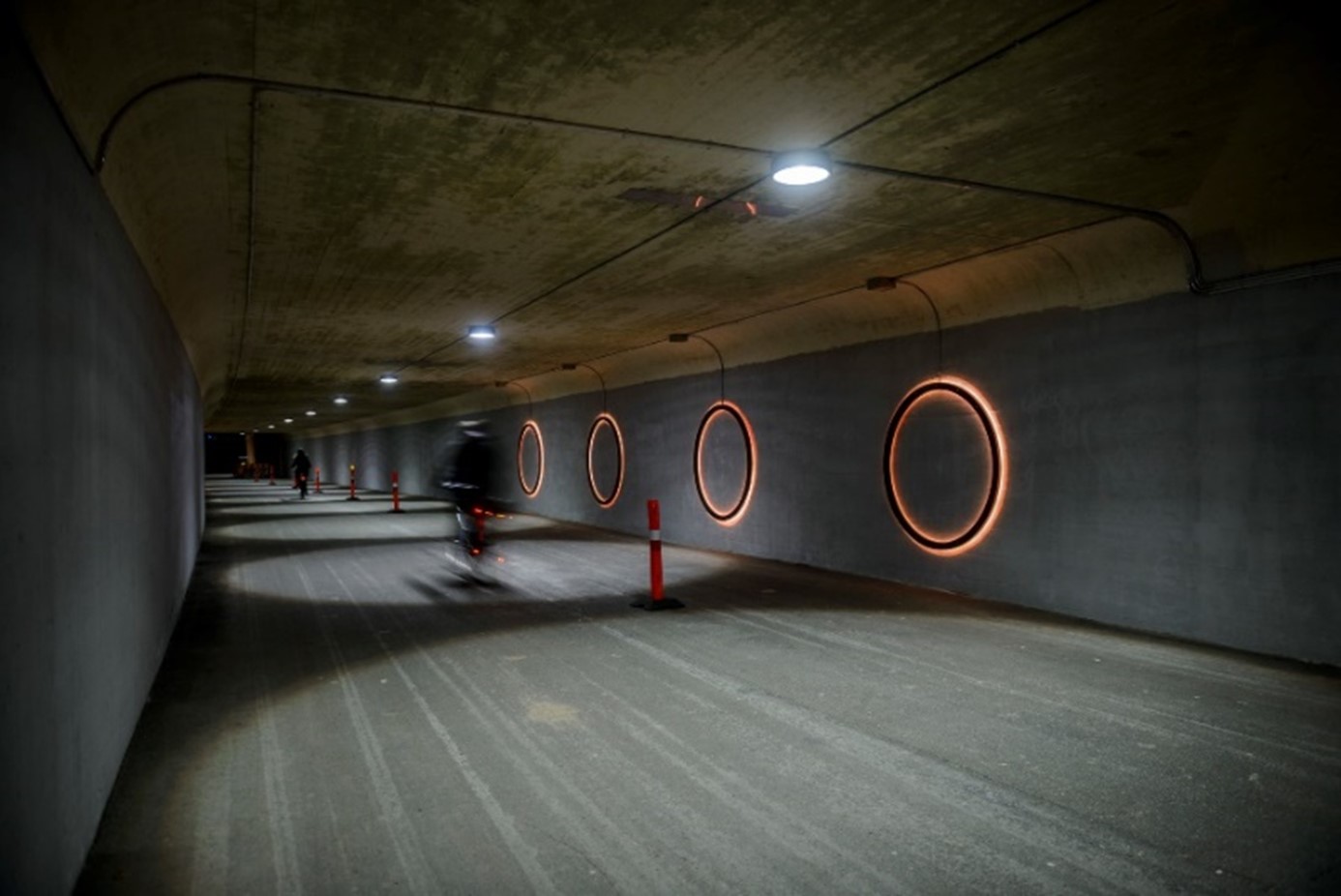
No steep slopes
On cycle superhighways, it should be possible to remain on the bicycle when entering and leaving underpasses. Therefore, it is recommended that approaches to underpasses should not have gradients greater than the recommendations outlined in the road regulations for paths.2Vejregler: Håndbog for Tracéring i byer, 2016, p. 54. Link. Therefore, it is recommended that the relationship between gradients and lengths does not exceed the values indicated in the following table:
| Gradient | Maximum Length | Elevation difference overcome |
| 5.0 percent (1:20) | 50 meters | 2.5 meters |
| 4.5 percent (1:22) | 100 meters | 4.5 meters |
| 4.0 percent (1:25) | 200 meters | 8.0 meters |
| 3.5 percent (1:29) | 300 meters | 10.5 meters |
| 3.0 percent (1:33) | 500 meters | 15.0 meters |
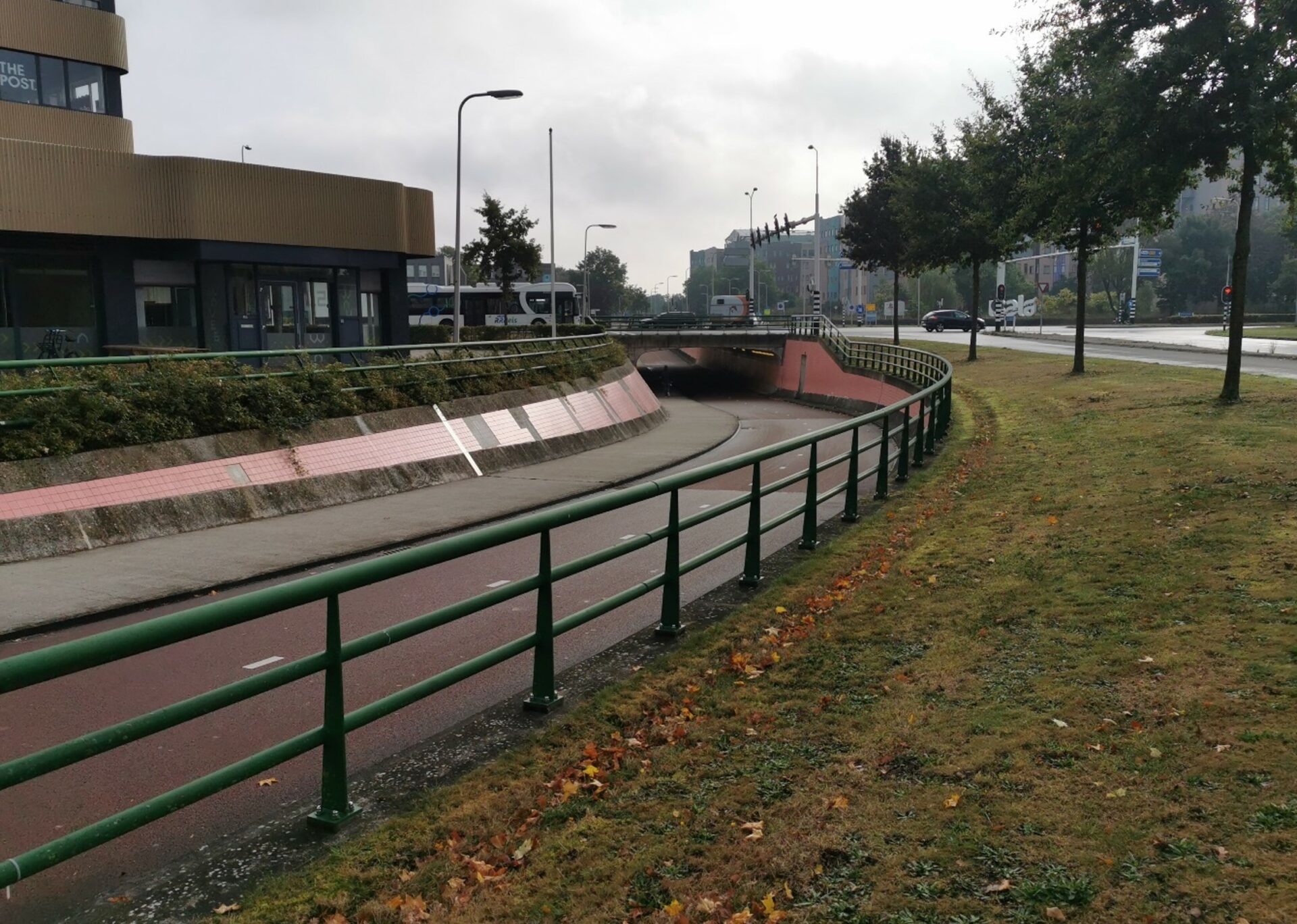
Attention to proper drainage
It is important to ensure that there is good drainage in underpasses to prevent water from collecting at the bottom of the underpass.
Read more here:
Using overpasses for crossings on cycle superhighways
Recommendations for establishing bike-pedestrian overpasses on cycle superhighways:
Wide overpasses and separation between cyclists and pedestrians
When deciding on the width of bike-pedestrian overpasses, it is important to take into consideration the expected future increase in bicycle traffic.
In addition, it is recommended to establish a separate area for pedestrians on the overpass, preferably with different paving and a curb, a cobblestone strip or similar.
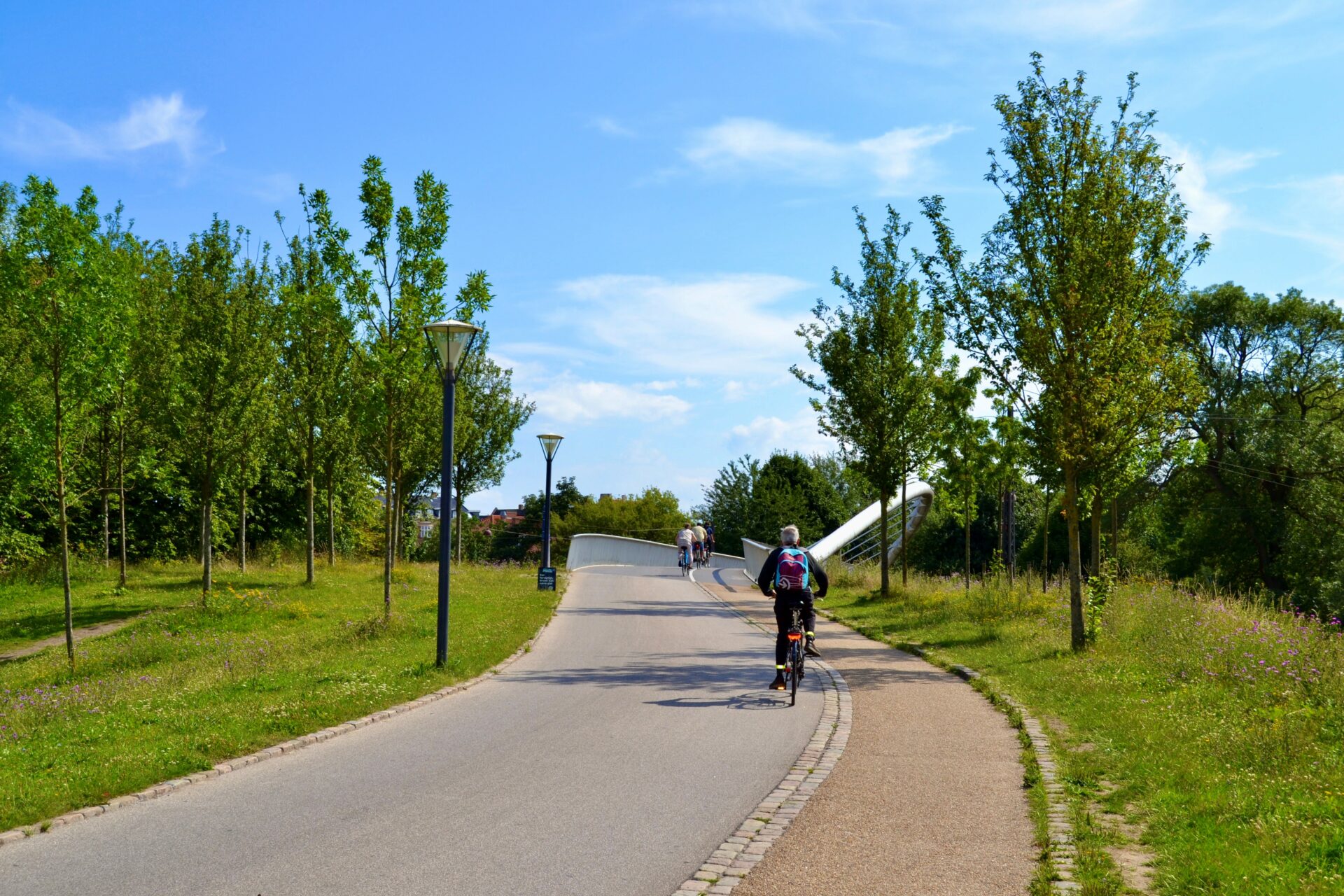
Ramp gradients are important
A bridge must normally have a clearance of 4.5 meters above the road, while for railway bridges there should typically be a clearance of between 7 and 8 meters above the railhead if the railway is electrified.3Transportministeriet: (CIR nr 162 af 17/09/1998) Cirkulære om vejregler for vejes geometri over og under broer. kap. 2. Link.
Ramps for footbridges should not be constructed with gradients steeper than the recommendations for paths in the Road Standards4: Håndbog for Tracéring i byer, 2016, p. 54 Link. Therefore, it is recommended that the ratio between gradients and lengths does not exceed the values specified in the following table.
| Gradient | Maximum Length | Elevation difference overcome |
| 5.0 percent (1:20) | 50 meters | 2.5 meters |
| 4.5 percent (1:22) | 100 meters | 4.5 meters |
| 4.0 percent (1:25) | 200 meters | 8.0 meters |
| 3.5 percent (1:29) | 300 meters | 10.5 meters |
| 3.0 percent (1:33) | 500 meters | 15.0 meters |
Railings with a minimum height of 1.2 meters
Bridges must be equipped with sufficiently high railings or guardrails. It is recommended that railings or guardrails area at least 1.2 meters high.
The bridge landing is crucial
It is important that the bridge’s connections on both sides take into account intersecting sidewalks, cycle tracks and roads,
Examples of bike and pedestrian bridges
Signalized intersections
When a cycle superhighway passes through an existing signalized intersection, a number of measures can be implemented to upgrade the intersection for the benefit of cyclists on the cycle superhighway. The measures can include physical improvements as well as technical signaling improvements. Click below to go directly to the different measures:
Establishing or converting to signalized intersections
When it is not possible to avoid a crossing on a cycle superhighway, signalized intersections are a good alternative under the right circumstances.
However, it is not necessarily an advantage for cyclists to signalize an intersection, as it can affect several parameters. Therefore, it is important to assess the need for signal control before making a decision to establish a new signal system or to convert an existing yield-controlled intersection to a signalized intersection.
If the signalization is established without a real need, there is a risk that road users will not respect the signalization.
To signalize an intersection, one or more of the following criteria must be met:
- Traffic intensity must be high
Road Standards stipulate that the total average hourly traffic entering a signalized intersection during the eight busiest hours of the day (not necessarily consecutive hours) should exceed 750 vehicles5Vejregler: Brug af trafiksignaler, 2018, p. 12. Link. - There must be long waiting times for side road traffic
The local conditions and individual assessments determine when a waiting time is too long, but for a cyclist, a waiting time of more than half a minute will often feel long. - There must be many pedestrians and cyclists
Road Standards stipulate that the total average hourly traffic of pedestrians and cyclists crossing the road during the four busiest hours of the day (not necessarily consecutive hours) should exceed 200 if this criterion is to be the main argument for the signalization. However, local conditions are of great importance6Vejregler: Brug af trafiksignaler, 2018, p. 12. Link. - Intersecting roads must be main roads
The roads that intersect must be part of the major road network. - There must be a specific risk of accidents that is expected to be reduced in a signalized intersection
A traffic signal system will improve traffic safety for all conflicts that are regulated directly in the signal system (cross-collisions). However, in signalized intersections without dedicated turn lanes (turn arrows), there are also conflicts that are regulated by yielding. For these conflicts, there is still a significant risk of accidents despite the signaling system. In signalized intersections, right-turn accidents and accidents involving left-turners, where drivers fail to yield properly, are particularly common. - The intersection must have poor visibility conditions
When converting an existing yield-controlled intersection on a cycle superhighway to a signal-controlled intersection, there are several factors to consider depending on whether it is a four- or three-way intersection.
Things to consider in signalized four-way intersections
When establishing a four-way intersection, the following factors should be considered:
Impacts for cyclists going straight ahead
Establishing a traffic signal at a four-way intersection will be an advantage for cyclists going straight ahead if they have difficulty crossing a heavy flow of traffic. Local conditions greatly influence what is perceived as a heavy flow of traffic. The key is that the waiting time should not be too long, so cyclists are not delayed at the intersection. If there are NOT many vehicles, bicycles or pedestrians that cyclists going straight ahead have to yield to, a four-way signal system can also cause poorer traffic flow compared to a four-way intersection controlled by yielding.
If there is NO yield requirement for a heavy flow of traffic, a four-way signal could instead result in poorer traffic flow compared to a four-way intersection controlled by yielding.
Impacts for cyclists turning right
For right-turning cyclists, a four-way signalized intersection will result in poorer traffic flow if they are required to stop on red at the signal. When converting intersections controlled by yielding to signalized intersections, traffic flow for right-turning cyclists can be improved by establishing a right-turn slip lane for cyclists or by allowing cyclists to turn right on red.
Click below to learn more about right-turn slip lanes and about allowing cyclists to turn right on red:
Impacts for cyclists turning left
A traffic signal at a four-way intersection will benefit left-turning cyclists if the status quo means that they have to yield to a heavy flow of traffic. If left-turning cyclists do NOT have to yield to a heavy flow of traffic, signalizing the intersection may lead to a reduced traffic flow for left-turning cyclists.
Things to consider in signalized three-way intersections (T-intersection)
When establishing a three-way intersection, the following factors should be considered:
Impacts for cyclists going straight ahead
Traffic signals at T-intersections are usually implemented if it is difficult for vehicles, cyclists, and pedestrians coming from the minor (side) road to cross the main road. For cyclists going straight ahead, a signalized T-junction is therefore rarely an advantage for traffic flow, as it entails extra stops.
If there is a cycle track on the main road, it is possible to let cyclists going straight on the main road (on the far side from the minor road) bypass the traffic signal. Also consider implementing a left-turn lane for cyclists from the main road towards the minor road, if space permits.
If the cycle track along the main road bypasses the traffic signal and a left-turn lane is implemented, be aware that some cyclists turning left onto the main road may not know who has the right of way along the main road.
Impacts for cyclists turning right
For right-turning cyclists to and from the minor road at intersections with a cycle track and/or bike lane, signalization is rarely an advantage for the traffic flow of cyclists.
When converting intersections controlled by yielding to signalized intersections, traffic flow for right-turning cyclists can be improved by establishing a right-turn slip lane for cyclists or by allowing cyclists to turn right on red.
Click below to learn more about right-turn slip lanes and about allowing cyclists to turn right on red:
Impacts for cyclists turning left
Left-turning cyclists from the minor road are regulated in the traffic signal as going straight ahead and are therefore relatively unproblematic. In signalized T-intersections, bicycle boxes with bicycle symbols can be established in front of the stop line for motorists. This allows cyclists to wait in front of the motorists at a red light.
You can learn more about the Cycle Superhighway Collaboration’s recommendations for bike boxes below.
If there is a cycle track “on the top of the T” and if space permits, it is possible to establish a left-turn lane for cyclists turning left from the main road to the minor road. It may be a good idea to give these cyclists the green signal before traffic from the minor road gets the green signal, or even give these left-turning cyclists their own phase in the traffic signal.
Removal of signalization in an intersection
When considering the removal of signalization from an intersection, the above criteria can also be reviewed. If few or none of the above criteria are met, it may be relevant to remove existing signalization from an intersection.
Improvements to existing signalized intersections
When a cycle superhighway runs through an existing signalized intersection, the entire intersection – including geometry and signal programming – should be reviewed with the aim of improving conditions for cyclists. This may involve physical measures as well as signaling measures.
Physical improvements
When a cycle superhighway passes through an existing signalized intersection, a number of measures can be implemented to upgrade the intersection for the benefit of cyclists on the cycle superhighway. The measures can include both physical and signaling improvements as well as additional service measures.
The following physical measures can help improve conditions for cyclists at signalized intersections:
Uninterrupted cycle track with a separate right-turn lane for cars
When a cycle superhighway runs through a signalized intersection, it is generally recommended to establish an uninterrupted cycle track where there is a separate right turn lane for vehicles (i.e., continuing the curb-separated cycle track all the way to the intersection as opposed to a truncated cycle track, which ends before the intersection and leaves cyclists to merge with right-turning vehicles), as this solution provides the best traffic flow for cyclists.
The uninterrupted cycle track can help minimize blind spots and increase safety for cyclists, as cyclists are guaranteed their own space. It also ensures good comfort and flow for cyclists as well as a visual and intuitive connection by continuing the cycle track all the way to the intersection.
An uninterrupted cycle track next to a separate right-turn lane for cars is significantly safer than an uninterrupted cycle track next to a combined straight-ahead and right-turn lane for cars. When establishing a new intersection, it is always recommended to provide a separate right-turn lane for vehicles next to an uninterrupted cycle track.
However, there can be different reasons for establishing either an uninterrupted or a truncated cycle track. Whether it should be one solution or the other should always be assessed based on several factors, such as the size of the intersection, traffic volumes, speed and the overall geometry of the intersection. If an uninterrupted cycle track with a separate right-turn lane for vehicles is not feasible, other solutions should be carefully considered.
Design of uninterrupted cycle tracks with separate right-turn lanes for cars:
- For traffic safety reasons, uninterrupted cycle tracks should only be established at signalized intersections if there is a separate right turn lane for vehicular traffic.
- The stop line for vehicles should be set back by a minimum of 5 meters, as this improves traffic safety on the uninterrupted cycle track. It also minimizes blind spots for truck drivers in particular, thereby helping prevent or reduce right-turn accidents7Vejdirektoratet (2022): Håndbog for Vejtekniske løsninger for cyklister – Effekt på sikkerhed og oplevet tryghed, p. 7. Link.
- At signalized intersections where the stop line for vehicles cannot be set back by a minimum of 5 meters, cyclists should be given an early green signal. This allows the flow of cyclists going straight to clear before right-turning vehicles enter the intersection8Vejdirektoratet (2022): Håndbog for Vejtekniske løsninger for cyklister – Effekt på sikkerhed og oplevet tryghed, p. 7. Link.
- The stop line on the cycle track should be pushed forward all the way to the pedestrian crossing9Vejregler (2022): Håndbog for Projektering af trafiksignaler, p. 39. Link.
- Good visibility conditions should always be ensured 30-50 meters before the intersection to reduce the risk of drivers overlooking cyclists and pedestrians10Vejregler (2018): Håndbog for vejkryds i byer, p. 82. Link. Where this is not possible, cyclists should be handled in a separate signal phase or a right-turn ban for vehicles should be established.
- For uninterrupted cycle tracks with a separate right-turn lane for vehicles, consider regulating cycle traffic in a separate green phase, as this is a safe and secure solution for cyclists. This solution removes the potential conflict between cyclists and right-turning drivers. However, this solution also reduces traffic flow for all road users as the green time becomes shorter with more signal phases. Here, a wider cycle track can help maintain capacity for cyclists at the intersection.
- Consider banning right turns for vehicles completely (cycles exempt). This solution will ensure traffic safety on uninterrupted cycle tracks because the conflict between cyclists going straight and right-turning drivers is completely eliminated.

Set-back stop line for vehicles
Establishing set-back stop lines for vehicles helps minimize blind spots, especially for truck drivers, and helps reduce right-turn accidents.
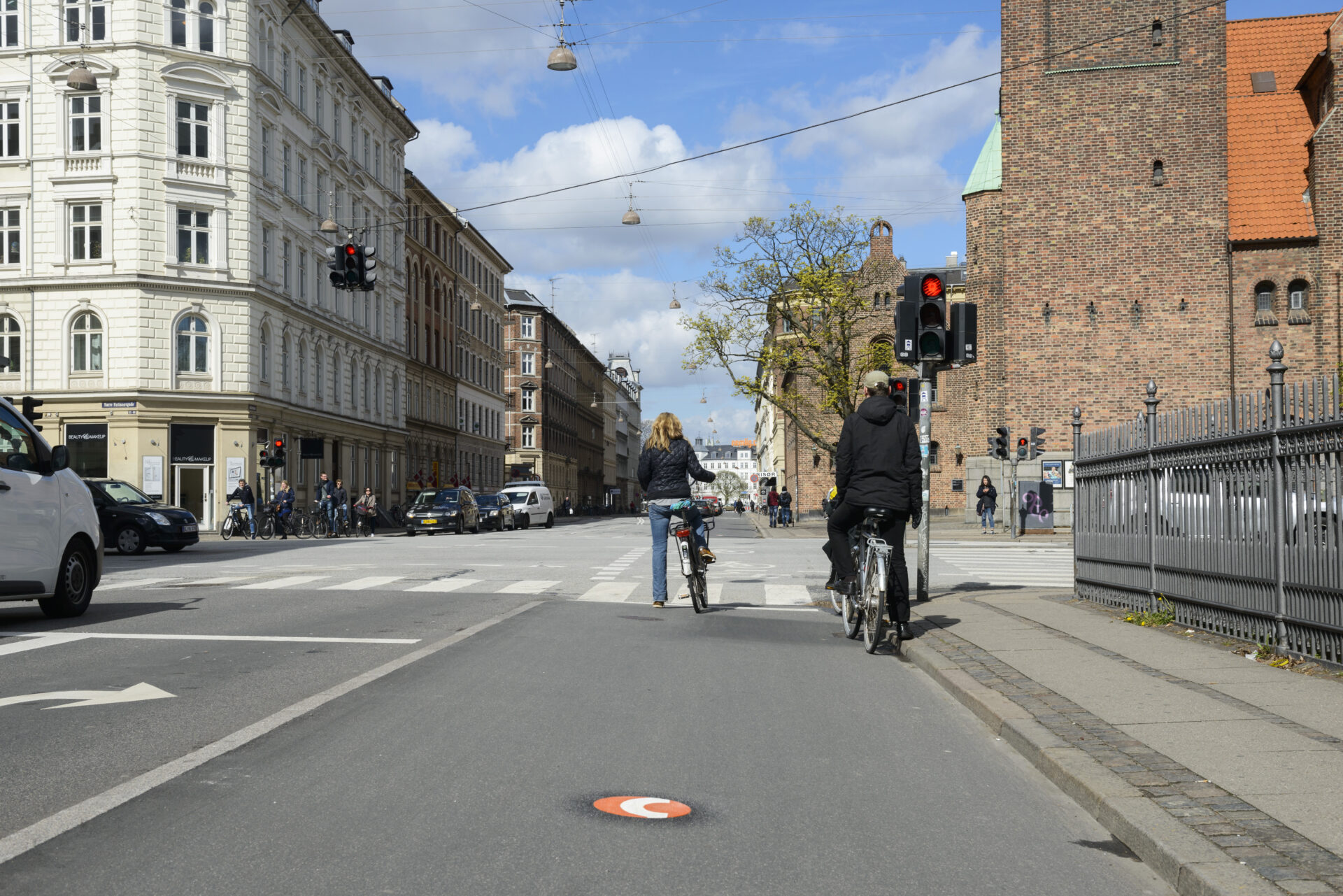
Cycle boxes
At signalized intersections, cycle boxes can be installed in front of the right-turn lane for vehicles. This gives cyclists priority in the intersection. The advantage is that cyclists have the opportunity to stop in front of drivers at red lights. This makes cyclists more visible to turning drivers and allows cyclists to enter the intersection before drivers. A cycle box should be established with a minimum depth of 5 meters, as a cyclist needs to be able to enter it in case of cyclists waiting ahead.
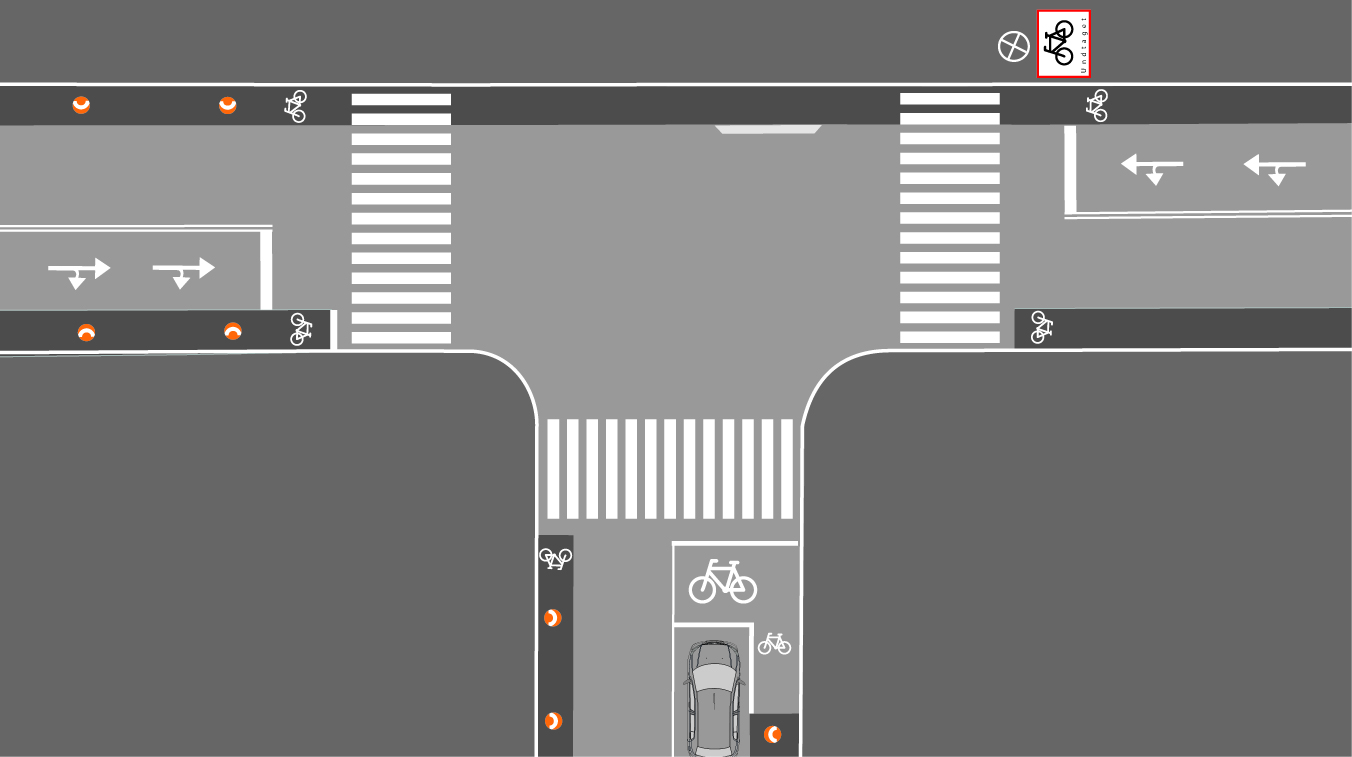
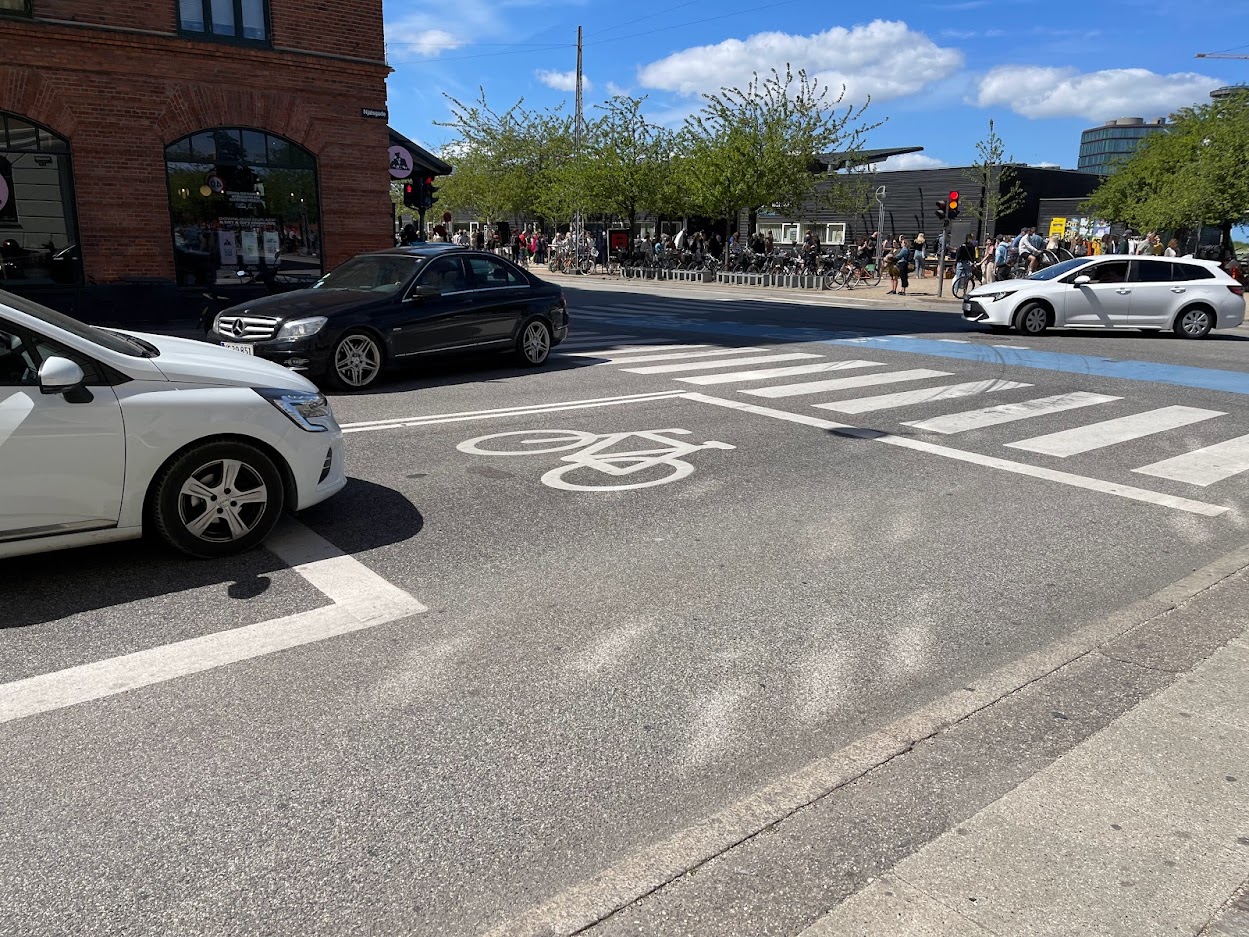
Cycle lanes and cycle symbols across the intersection
Establishing cycle lanes with wide dashed lines supplemented with cycle symbols and possibly blue-colored cycle zones at intersections can help guide cyclists across the intersection and make other traffic aware of cyclists.
For safety reasons, the use of blue cycle zones should be limited to one or at most two of the directions of travel, in order to maintain the design as something special that stands out from regular intersections12Jensen, S. U. : Effekter af overkørsler og blå cykelfelter. Trafitec, 2006. Link.
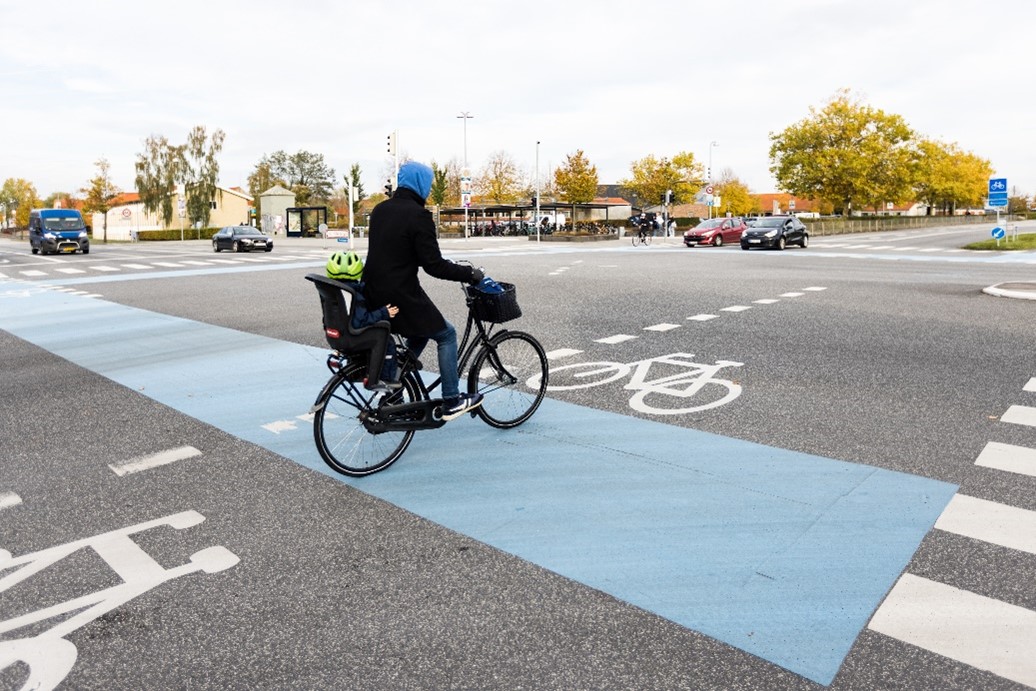
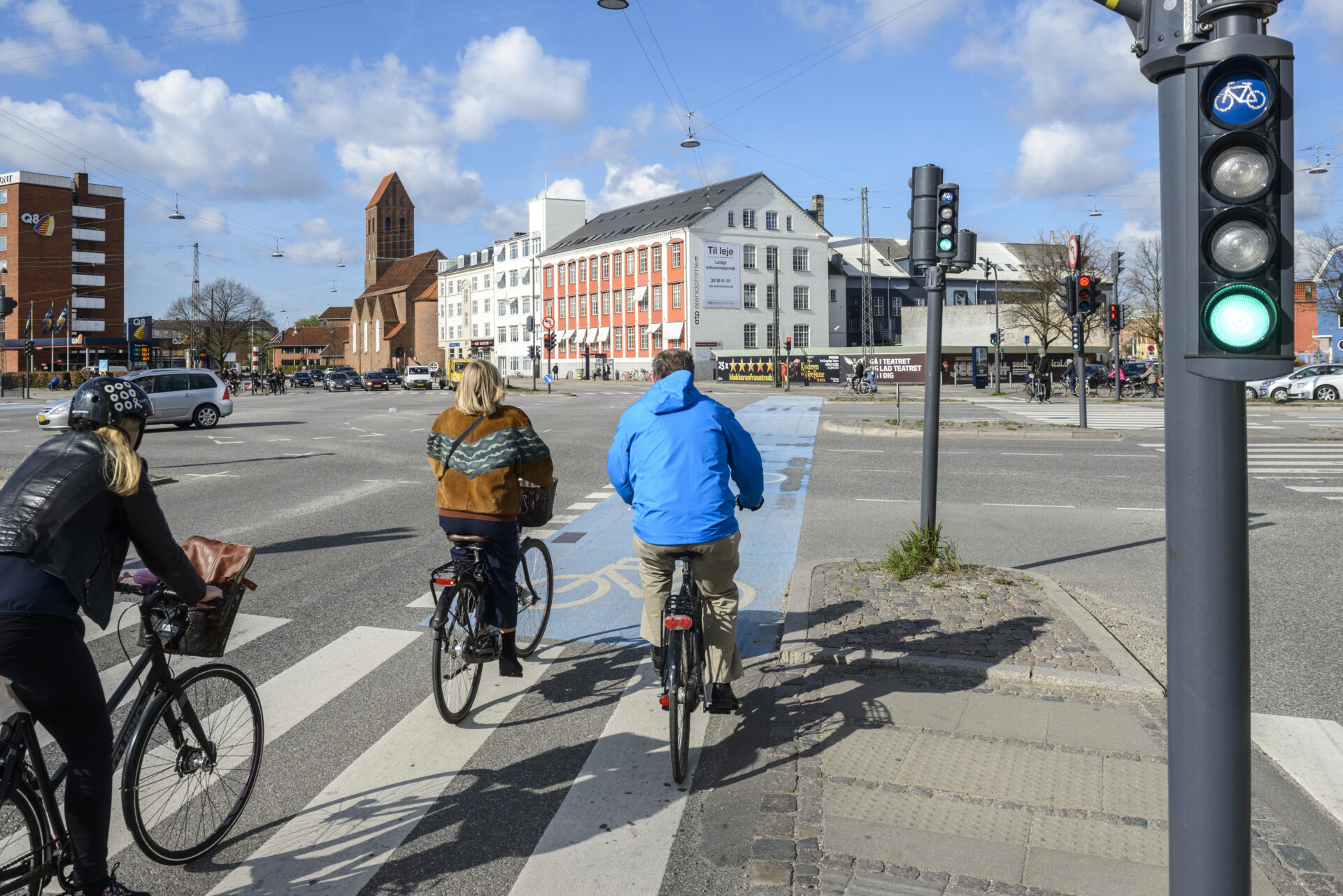
Cyclists exempt from red lights
If the cycle superhighway runs along the “top bar of the T” of the T-intersection (the main road), cyclists’ traffic flow can be improved by exempting them from the traffic signals and requiring them to yield to crossing pedestrians and cyclists from and to the minor road. This solution is only recommended in intersections with few pedestrians and few cyclists from and to the minor road.
If cyclists on the “top bar of the T” are allowed to bypass the traffic signal, it is generally recommended to require these cyclists to yield for left-turning cyclists from the side road. This is to ensure that the left-turning cyclists from the side road clear the intersection quickly.
If the amount of cycle traffic from the side road is very limited, it may be considered to require cyclists from the side road to yield to ensure maximum traffic flow along the cycle superhighway.
In three-way intersections, it is important to pay special attention to cyclists from the main road turning left onto the minor road. If there are many left-turning cyclists, it is recommended to establish a left-turn lane for them and and to manage their movements in their own phase separate from traffic from the other directions.
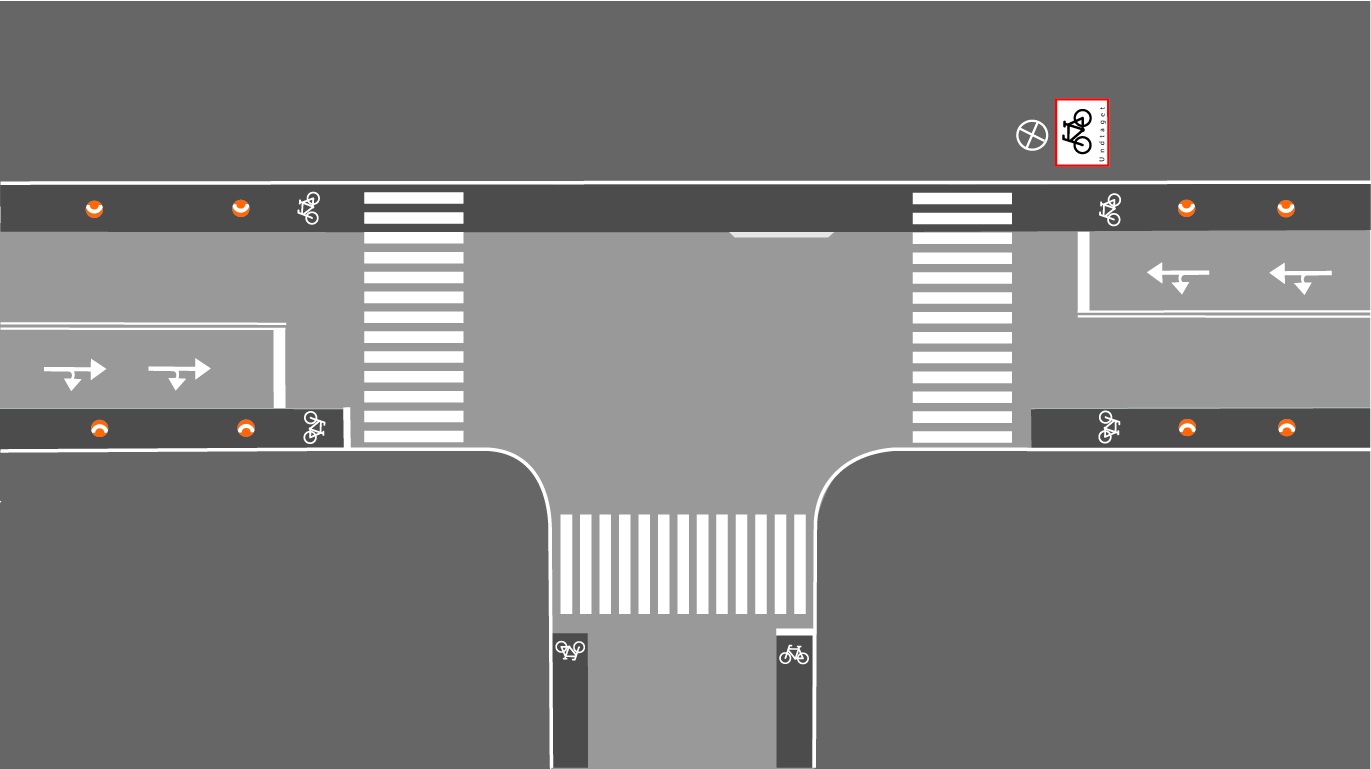
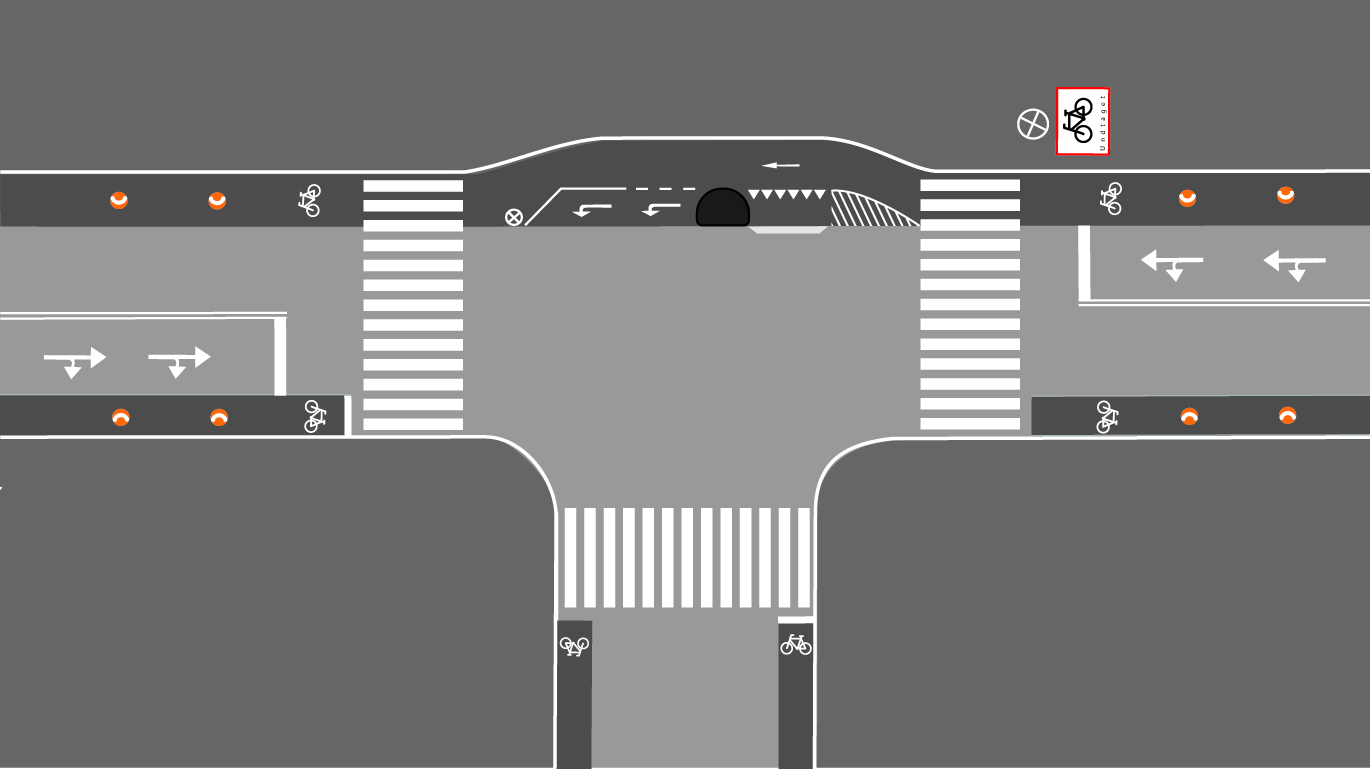
Allowing right turns on red
If a cycle superhighway turns right at a signalized intersection, it can be a good idea to allow right turns on red. This measure improves traffic flow and ensures the possibility for cyclists to turn right even when the signal is red. The solution requires the following conditions to be met13Vejregler: Håndbog i Projektering af trafiksignaler, 2022, p. 24f. Link, 14Transportministeriet: Bekendtgørelse om anvendelse af vejafmærkning, § 225, 2023. Link:
1) There must be a separate cycle track on the approach to the intersection as well as leading away from the intersection to the right,
2) The cycle track must be divided into a through lane and a right-turn lane with a total width of at least 1.85 meters including a continuous line dividing the cycle track,
3) The through lane and the right-turn lane must each be a minimum of 0.925 meters wide measured from the curb to the center of the continuous line dividing the cycle track,
4) The right-turn lane must be marked with a right-turn arrow for cyclists,
5) The right-turn lane must be marked with an S 11 yield line (“shark’s teeth”), as close as possible to crossing cyclists and
6) The distance to fixed objects must be at least 0.30 meters.
Additionally, one should be aware of the number of pedestrians. If there are many pedestrians, the risk of accidents between cyclists and pedestrians increases.
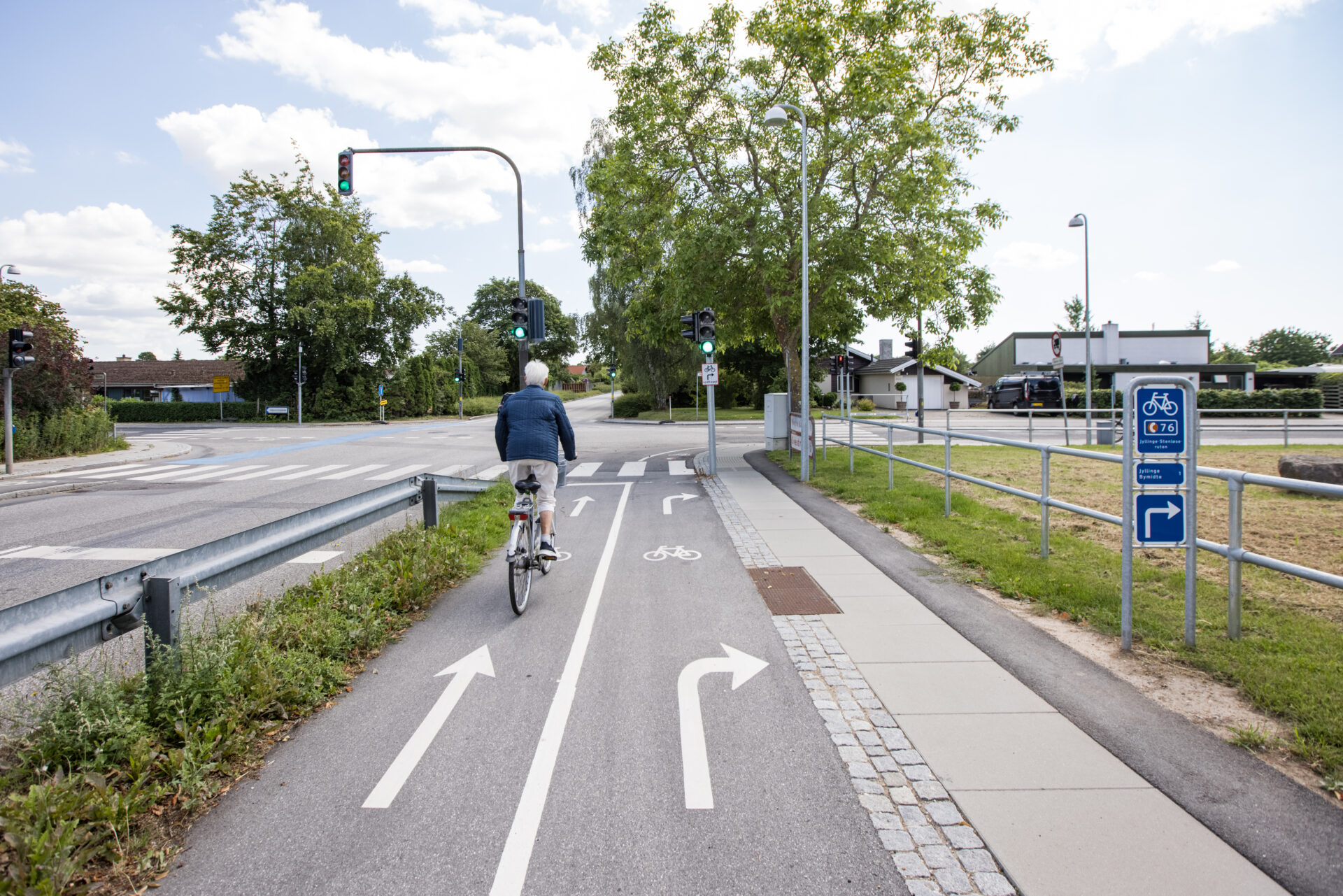
Right-turn slip lane
If there is ample space at the corner of an intersection where the cycle superhighway turns right, it can be an advantage to establish a right-turn slip lane for cyclists. This avoids right-turning cyclists having to stop for red lights. There should be room for a cycle track of at least 2.0 meters to bypass the traffic signal.
The measure reduces accessibility and perceived security for pedestrians who have to cross the cycle slip lane to reach the crosswalk. Therefore, the measure is best implemented in locations where there are no large pedestrian flows.
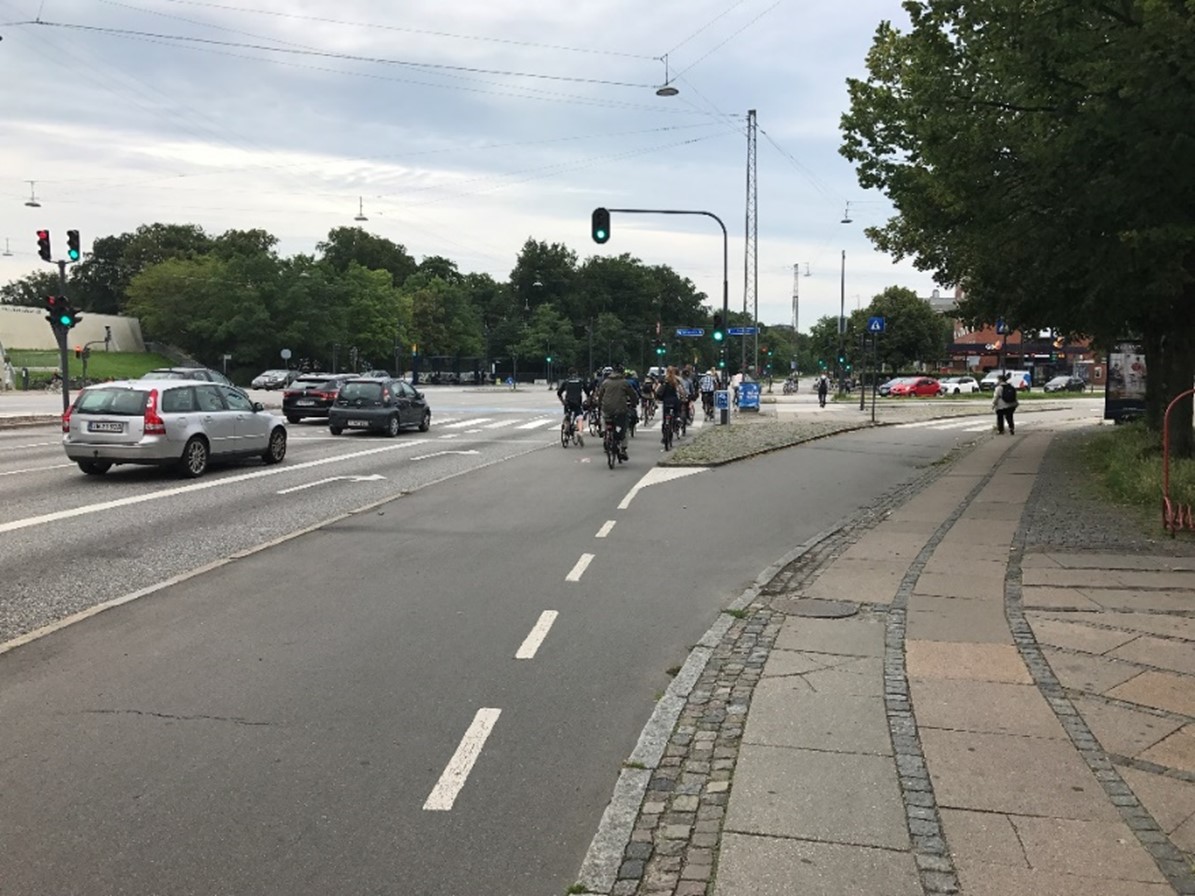
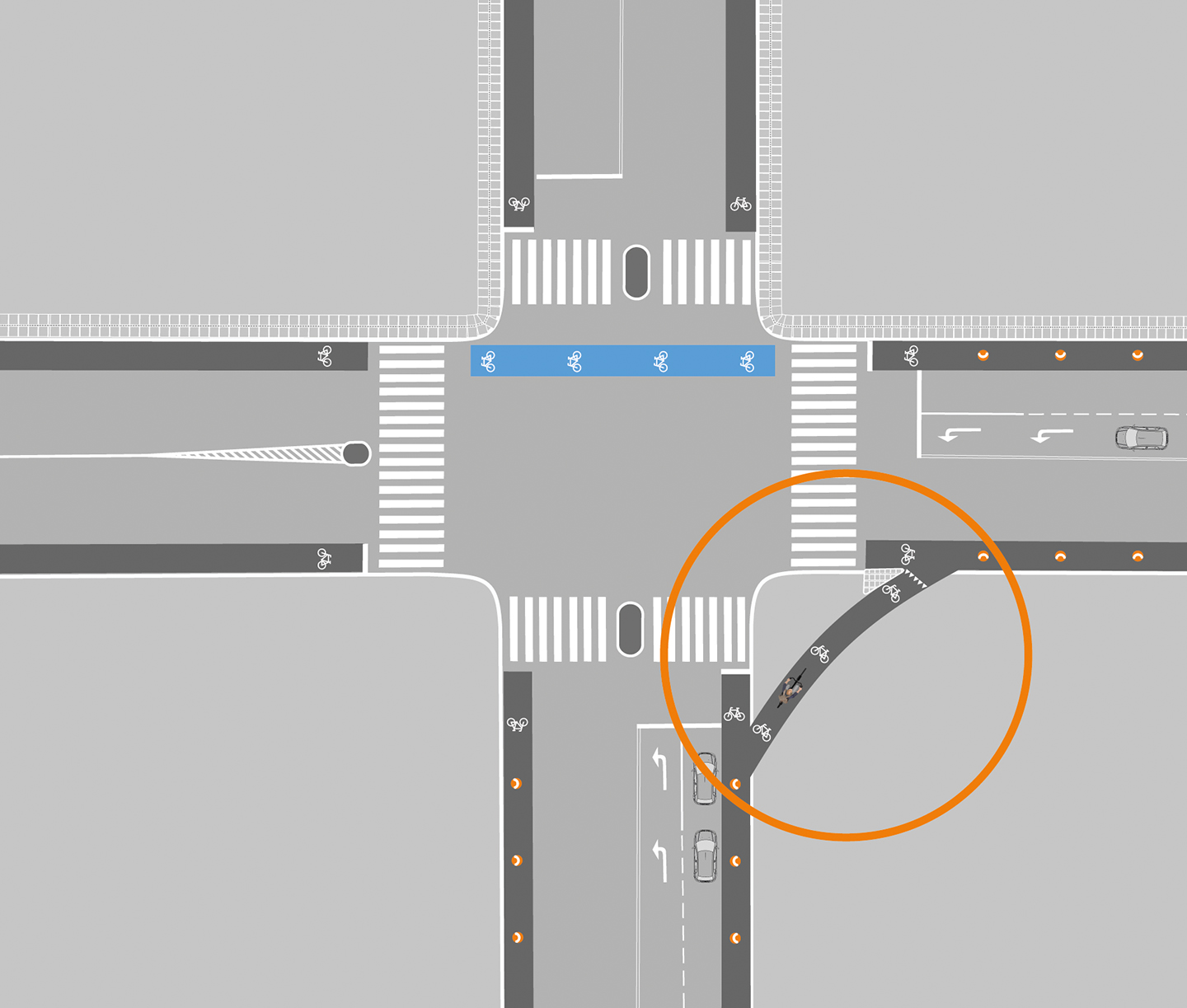
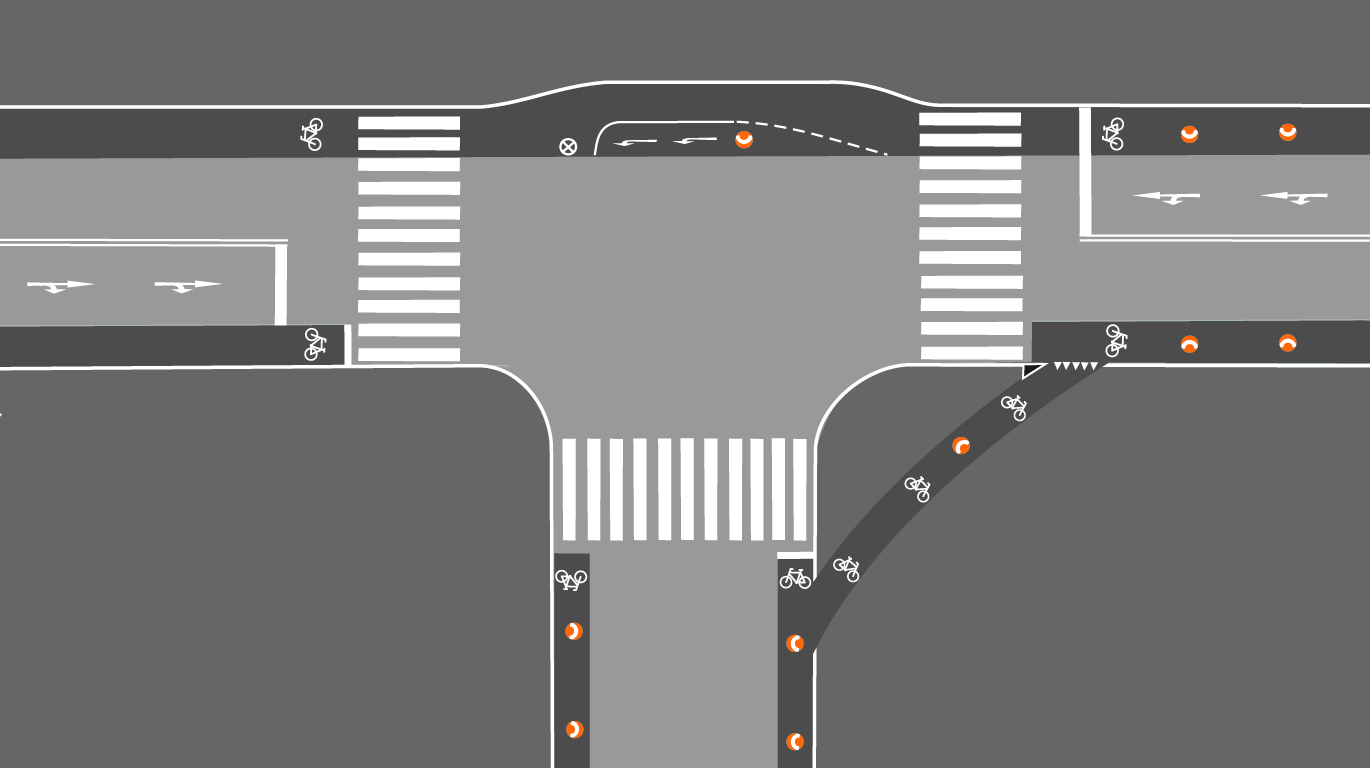
In this T-intersection, left-turning cyclists are accommodated with their own signalized left-turn lane and right-turning cyclists with a right-turn slip lane. If it is not possible to establish a right-turn slip lane, it should be investigated whether right-turning cyclists can be allowed to turn right on red.
Optimizing waiting space for left-turning cyclists in four-way intersections
In signalized intersections on cycle superhighways, it is important to consider left-turning cyclists if the intersection represents a change of direction for the cycle superhighway.
In a four-way intersection, most cyclists will make a left turn by continuing through the intersection and waiting for a green light on the opposite corner after crossing one road segment. It is therefore important to design the intersection so that left-turning cyclists can safely stop on the corner without being a hindrance to pedestrians in the crosswalk. Especially if there are many left-turning cyclists, it can be difficult to ensure that everyone can stop and wait safely. Markings on the roadway can help cyclists to position themselves appropriately when turning left. In intersections where the traffic signals are traffic-controlled rather than time-controlled, induction loops in the left-turn lane can be added to detect cyclists in the signal.
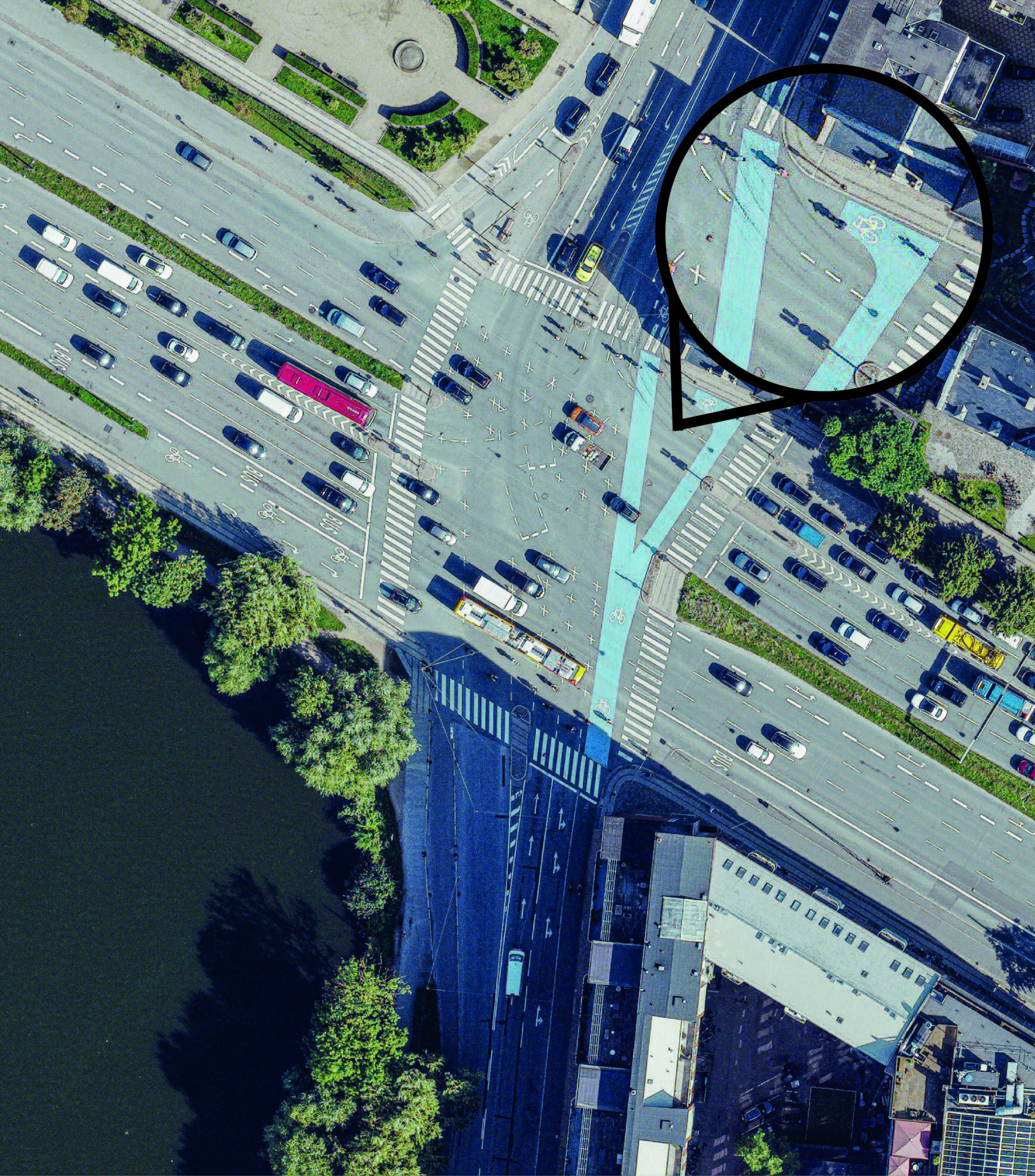
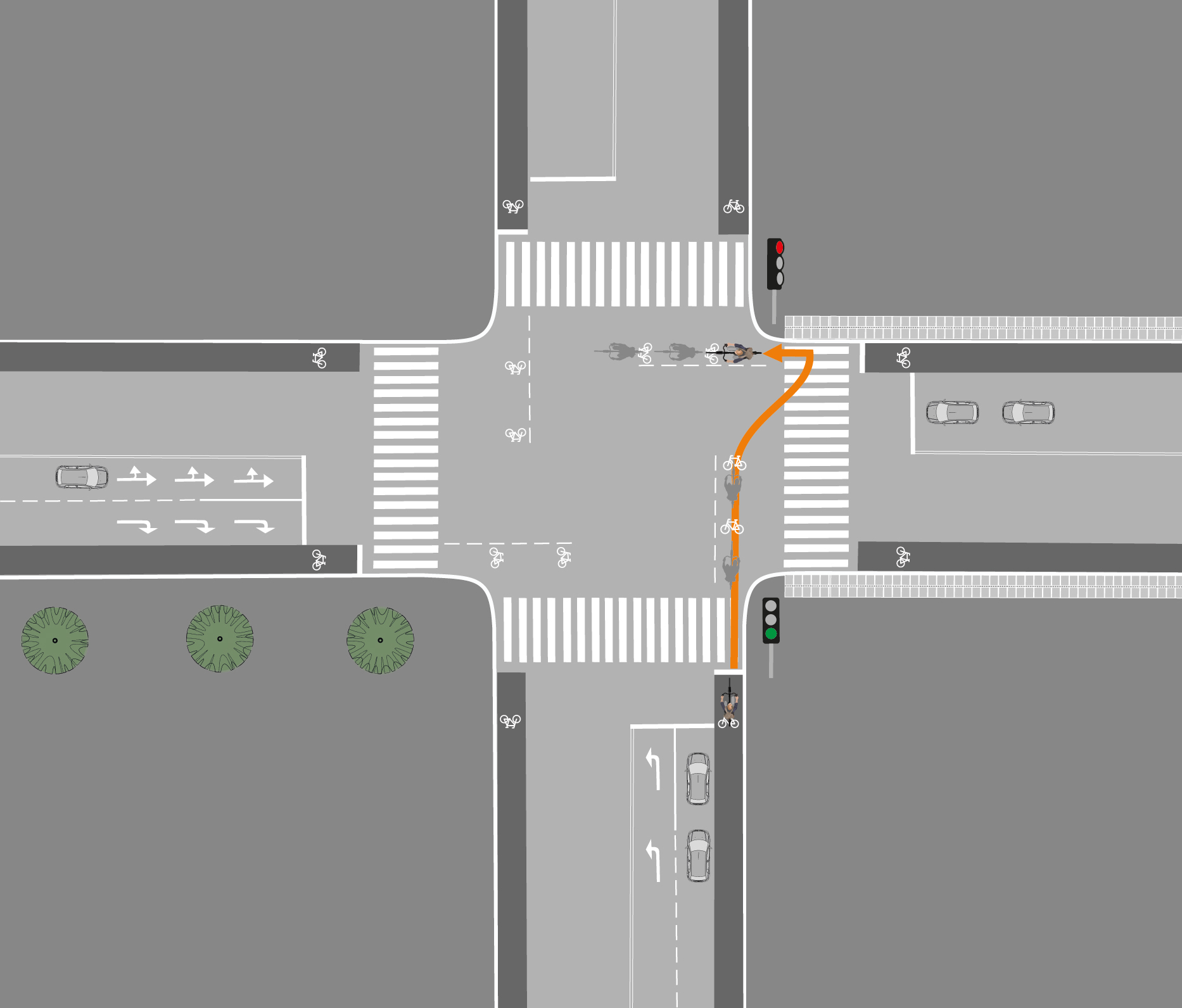
Implementing left-turn lanes in T-intersections
If the cycle superhighway changes direction at a T-intersection, traffic flow can be improved by establishing a signalized left-turn lane and right-turn slip lane from the minor road. If it is not possible to establish a right-turn slip lane, it should be investigated whether right-turning cyclists can be allowed to turn right on red.
For safety reasons, it is a good idea to completely separate the cycle and vehicle phases in the signal program. This can result in short green times and generally poorer traffic flow at the intersection. Alternatively, cyclists can get an early green light in advance of drivers so the cyclists can pass the conflict zone before vehicles reaches the conflict zone. Read more in the section on early green lights.
If there is a significant amount of cyclists to and from the minor road, consider establishing a left-turn lane for cyclists from “the top of the T” to the minor road as well as a space for cyclists turning left from the minor road onto the major road, allowing them to yield to cyclists going straight on “the top of the T” without stopping on the roadway, if cyclists on “the top of the T” are exempt from the traffic signals.
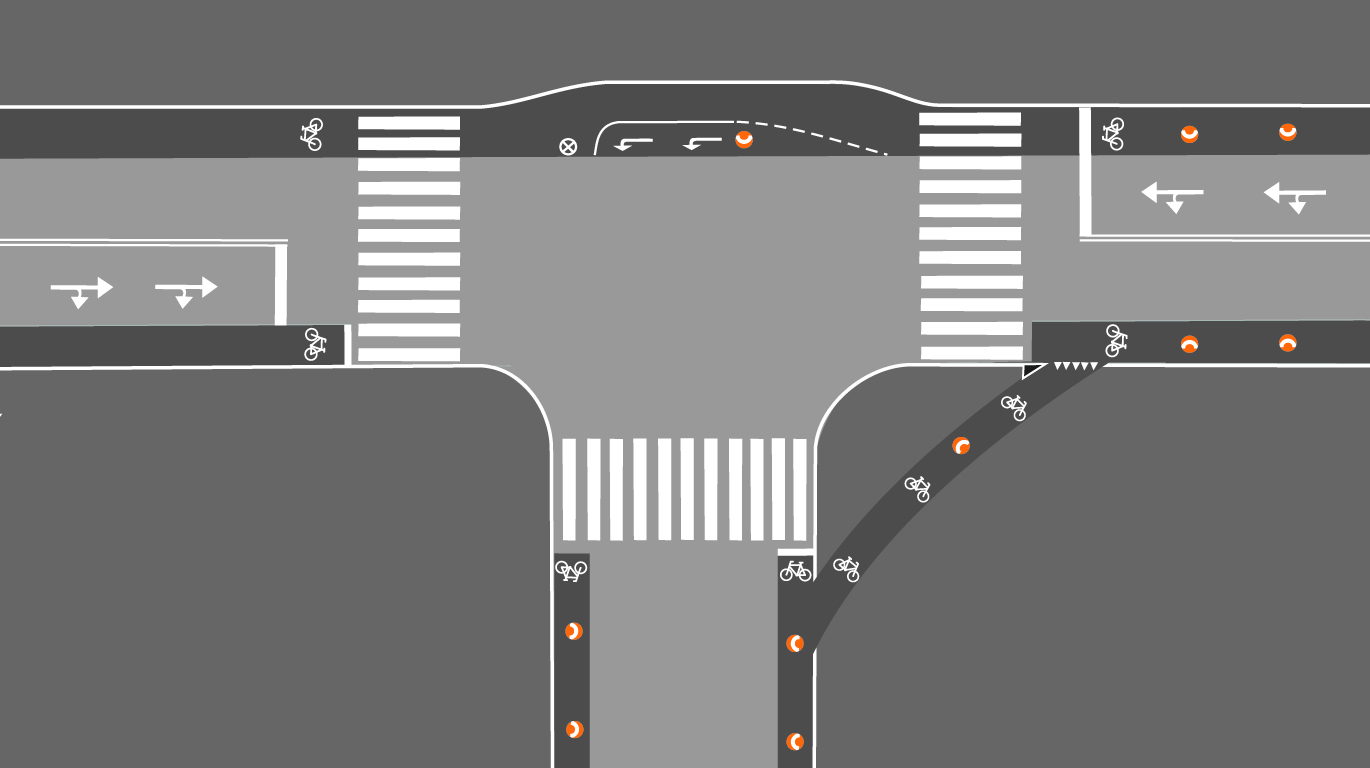
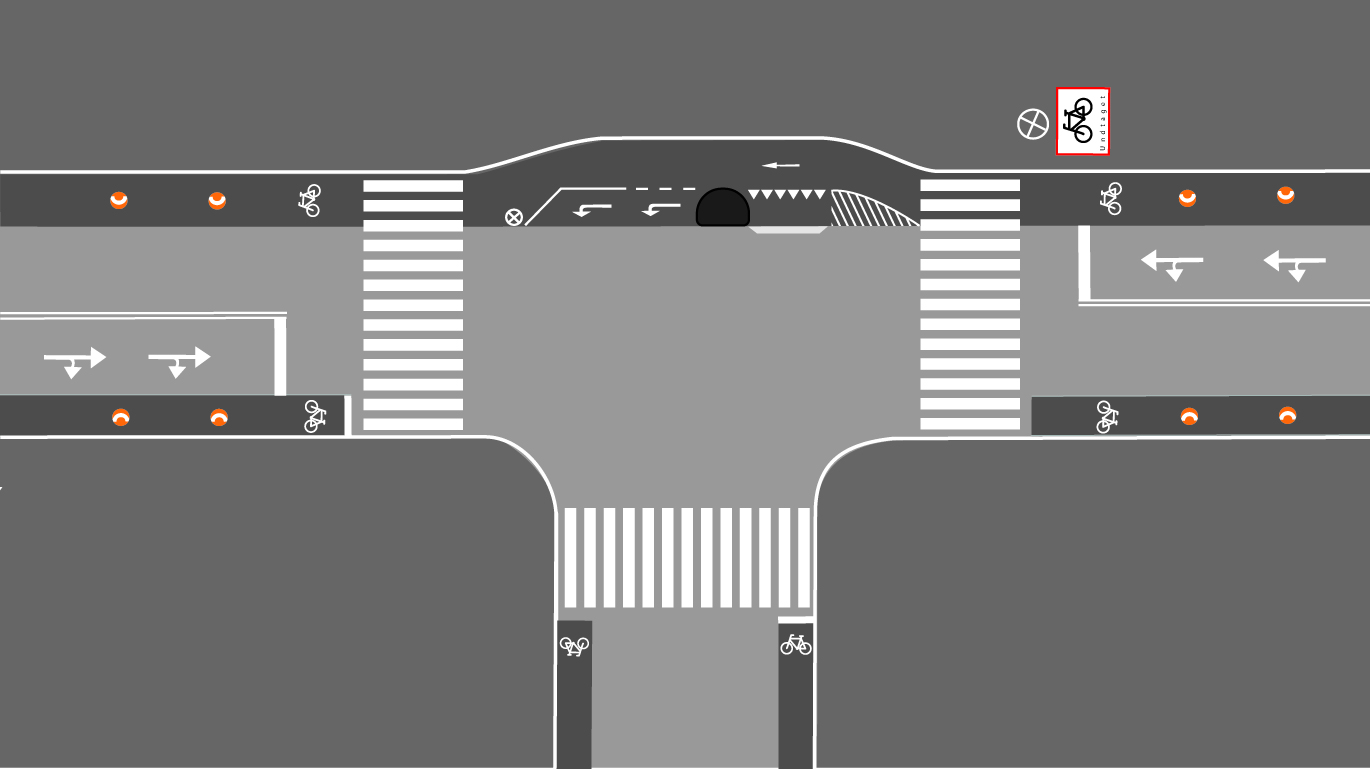
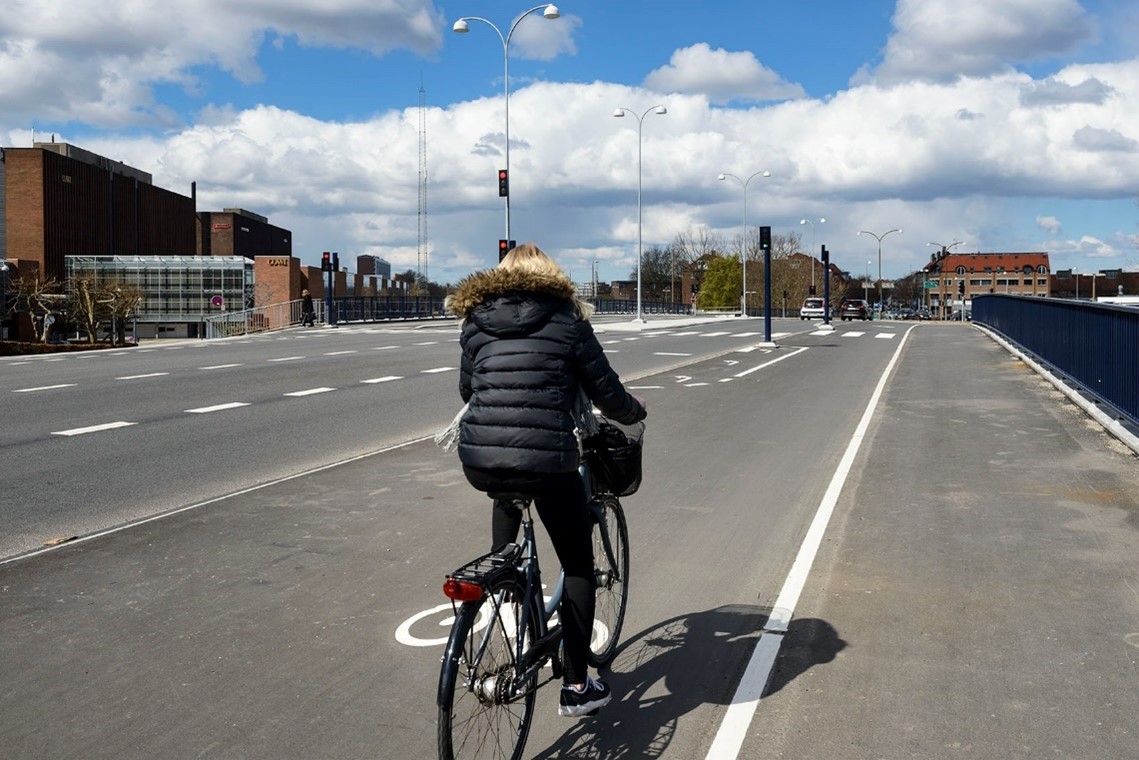
Things to consider on the approaches to signalized intersections
When a cycle superhighway passes through a signalized intersection, it is generally recommended to establish an uninterrupted cycle track, as this solution provides the best traffic flow for cyclists.
Read more about how to design an uninterrupted cycle track next to a separate right-turn lane for vehicles here:
However, there may be various reasons for establishing either an uninterrupted or a truncated cycle track. Whether it should be one or the other should always be assessed in relation to several circumstances, such as the size of the intersection, traffic volumes, speed and the overall geometry of the intersection.
If an uninterrupted cycle track next to a separate right-turn lane for vehicles is not possible and another solution is desired, the following points of attention should be considered.
Truncated cycle tracks in dense, built-up areas
Using an uninterrupted cycle track next to a separate right-turn lane can be problematic in densely built-up areas with higher traffic volumes and limited space at the intersection. If space is tight or if high-speed cyclists can be expected (e.g., at intersections at the end of a hill), a truncated cycle track will often be the best compromise between traffic flow and safety for cyclists. With a truncated cycle track, the cycle track stops before the intersection and cyclists merge with right-turning drivers in the right-turn lane.
From a traffic safety perspective, the truncated cycle track is considered a good solution, as the risk of right-turn accidents is lower with a truncated cycle track. Therefore, this solution is often preferable at signalized intersections with a high incidence of right-turn accidents if it is not possible to establish an uninterrupted cycle track with separate control or to prohibit right turns for vehicles.
The point of conflict between cyclists and right-turning drivers is moved away from the intersection by the truncated cycle track. Instead, the point of conflict is shifted backwards to the merging point on the approach to the intersection, where road users’ attention is increased because they have to share the space and therefore have to orient themselves in relation to each other.
Although the solution is good from a statistical traffic safety perspective, it may be perceived as an unsafe solution by the majority of cyclists16Vejdirektoratet: Håndbog for vejtekniske løsninger for cyklister – Effekt på sikkerhed og oplevet tryghed, 2022, p. 5 Link, as it can create uncertainty about where cyclists should position themselves in relation to drivers, and sharing road space with vehicles can feel unsafe. It can also be confusing for drivers as cyclists can position themselves on both the right and left side of the vehicle. Therefore, truncated cycle tracks should only be established at intersections where there are few right-turning drivers. In these cases, one should reconsider whether it is possible to prohibit right turns for vehicles, thereby allowing for a truncated cycle track without the risk of conflicts.
Design of truncated cycle tracks in densely built-up areas:
- For truncated cycle tracks, the combined cycle lane and right turn lane should have a width of at least 3.5-4.0 meters17: Håndbog for vejtekniske løsninger for cyklister – Effekt på sikkerhed og oplevet tryghed, 2022, p. 5 Link. This width ensures that cyclists can position themselves next to the driver, while preventing two drivers from positioning themselves next to each other.
- The length of the combined cycle lane and right-turn lane should be 15-25 meters18Vejdirektoratet: Håndbog for vejtekniske løsninger for cyklister – Effekt på sikkerhed og oplevet tryghed, 2022, s. 10 Link. Additionally, good visibility conditions should be ensured 30-50 meters before the cycle track is truncated19Vejregler: Håndbog for vejkryds i byer 2018 Link. If good visibility conditions cannot be ensured, a truncated cycle path should not be used.
- When using a truncated cycle path, it is a good idea to mark the combined cycle lane and right-turn lane with two to three large cycle symbols. The first cycle symbol should be placed immediately after the cycle track is truncated. The last cycle symbol should be positioned in the combined cycle lane and right-turn lane, where the dashed line between the two lanes ends and becomes a solid line.
- Truncated cycle tracks should not be considered if there are many right-turning vehicles at the intersection as it reduces traffic flow and comfort for cyclists. Similarly, there should not be any bus routes turning right or a large volume of heavy traffic at truncated cycle paths in signalized intersections in densely built-up areas.

Truncated cycle tracks with cycle track/cycle lane to the left of the right-turn lane for vehicles
At signalized intersections with a truncated cycle track, where there are many cyclists going straight, consider establishing a cycle track or cycle lane to the left of the right-turn lane for vehicles. This contributes to better comfort and flow for cyclists compared to a regular truncated cycle track. However, the perceived safety is lower than with an uninterrupted cycle track. By establishing a cycle track or cycle lane to the left of a right-turn lane at the end of a truncated cycle track, the dangerous conflicts between right-turning drivers and cyclists going straight are replaced with less dangerous merging situations before the intersection itself20Vejdirektoratet: Håndbog for vejtekniske løsninger for cyklister – Effekt på sikkerhed og oplevet tryghed, 2022, p. 10 Link.
Design of truncated cycle tracks with cycle path/cycle lane to the left of the right-turn lane:
- Truncated cycle tracks with a cycle track or cycle lane to the left of the right-turn lane for vehicles should be designed so that the cycle track continues straight ahead, while drivers have to change direction when crossing the cycle lane. This helps drivers to slow down and orient themselves in the merging situation.
- If there is a high proportion of right-turning drivers, an uninterrupted cycle track can be provided for the right-turning cyclists.
- The length of the combined cycle land and right turn lane should be 15-25 meters21Vejdirektoratet: Håndbog for vejtekniske løsninger for cyklister – Effekt på sikkerhed og oplevet tryghed, 2022, p. 5 Link. In addition, good visibility conditions should be ensured for the last 30-50 meters before the merging situation22Vejdirektoratet: Håndbog for vejtekniske løsninger for cyklister – Effekt på sikkerhed og oplevet tryghed, 2022, s. 5 Link. If good visibility conditions cannot be ensured, a truncated cycle track should not be used.
- If this solution is designed with a cycle lane rather than a (curb-separated) cycle track, the cycle lane should have a width of at least 1.5 meters including the edge line towards the through lane, and the width of the right-turn lane should be 3.5 meters. There should also be a crossing zone between right-turning cars and cyclists going straight23Vejdirektoratet: Håndbog for vejtekniske løsninger for cyklister – Effekt på sikkerhed og oplevet tryghed, 2022, p. 10 Link.
- The merging point should be marked as a blue cycle zone to increase awareness among all road users in the merging situation. If a cycle lane is constructed instead of a cycle track from the merging point to the intersection, this cycle lane should also be marked as a blue cycle zone.


Truncated cycle track with cycle lane along the curb up to the stop line
There may be signalized intersections where there is no space to carry the wide, uninterrupted cycle track all the way to the intersection, but where a truncated cycle track is also not considered the best solution. In such cases, a narrow cycle lane along the curb all the way to the stop line can be considered as a compromise between traffic flow and safety for cyclists. This solution should only be considered if there are many right-turning drivers and few cyclists going straight ahead. If there are many cyclists going straight ahead, you should instead consider routing the cycle track to the left of the right-turn lane or choose a “traditional” truncated cycle track.
Truncated cycle track with cycle lane along the curb up to the stop line:
- The stop line for the right-turn lane for vehicles should be set back by a minimum of 5 meters, as this improves traffic safety on the uninterrupted cycle track. A stop line for vehicles that is set back by at least 5 meters minimizes blind spots, especially for truck drivers, and can therefore help prevent or reduce right-turn collisions.
- The cycle lane should have a minimum width of 1.5 meters including the edge line and the width of the right-turn lane should be 3.5-4 meters24Vejdirektoratet: Håndbog for vejtekniske løsninger for cyklister – Effekt på sikkerhed og oplevet tryghed, 2022, p. 10 Link.
- Good visibility conditions should always be ensured for the last 30-50 meters before the cycle lane is truncated25Vejregler: Håndbog for vejkryds i byer, 2018, p. 82 Link. If good visibility conditions cannot be ensured, a truncated cycle track should not be used.
- The solution can be supplemented with a cycle box in front of the right-turn lane to improve traffic flow for cyclists going straight ahead.

Uninterrupted cycle tracks at combined through and right-turn lanes
Uninterrupted cycle tracks next to a combined straight and right-turn lane for vehicles is not recommended as this solution causes the most collisions26: Håndbog for vejtekniske løsninger for cyklister – Effekt på sikkerhed og oplevet tryghed, 2022, p. 7 Link.
Uninterrupted cycle tracks next to a combined straight and right-turn lane should only be considered if there are few or no right-turning vehicles. In such cases, however, prohibiting right turns for cars should be considered instead.
Design of truncated cycle tracks when through lanes and right-turn lanes are combined:
- When an uninterrupted cycle track runs alongside a combined through and right-turn lane, it should be considered to regulate cycle traffic with a separate green phase, as this is a safe and secure solution for cyclists. This approach eliminates the potential conflict between cyclists and right-turning drivers. However, this solution reduces traffic flow for all road users, as the green time is shorter with more signal phases. In this case, a wider cycle track can help maintain capacity for cyclists at the intersection.
- The stop line for the combined through and right-turn lane should be set back by a minimum of 5 meters, as this improves traffic safety on uninterrupted cycle tracks. A stop line set back by at least 5 meters for drivers minimizes blind spots, especially for truck drivers, and can therefore help prevent or reduce right-turn accidents27Vejdirektoratet: Håndbog for vejtekniske løsninger for cyklister – Effekt på sikkerhed og oplevet tryghed, 2022, p. 7 Link.
- Good visibility conditions should always be ensured 30-50 meters before the intersection to reduce the risk of drivers overlooking cyclists and pedestrians28Vejregler: Håndbog for vejkryds i byer, 2018, p. 82 Link.
- A complete ban on right turns for vehicles should be considered (cycles exempt). This solution increases traffic safety for cyclists because the conflict between cyclists going straight ahead and right-turning drivers is completely eliminated.

Technical signaling measures
Technical signaling measures can be implemented when establishing new signalized intersections as well as when optimizing existing ones. The following technical signaling measures can help optimize conditions for cyclists at signalized intersections:
Find more information in the sidebar on the left
Detection
Detection is a good way to prioritize cyclists in a signalized intersection. It can help reduce stops and ensure cyclist flow. Detecting cyclists can be challenging as cyclists can position themselves more dynamically in the intersection and on the cycle track than, for example, drivers on the road who position themselves in the same place in the roadway.
To detect cyclists, several different methods can be used:
Radar
Radar detection is often used in newer signaling systems.
Things to consider:
Radar technology generally can only detect objects that are moving towards or away from the radar. For instance, left-turning cyclists may not be detected by radar. Additionally, radars may struggle to detect accurately when there are tall buildings surrounding an intersection.
Thermal camera
Thermal cameras are effective at detecting stationary cyclists such as left-turning cyclists.
Things to consider:
Thermal cameras used in traffic signal systems often have limited range, which means they may not detect cyclists far from the intersection.
Video
Video can detect cyclists at a distance from the intersection as well as stationary cyclists in the intersection.
Things to consider:
The drawback of video is that it reacts to changes in pixels within the video image. This means that in foggy or dark conditions, the technology may not provide reliable detection – especially if the cyclist does not have lights on their cycle.
Induction loops
Induction loops embedded in the pavement can provide effective detection of cyclists. These loops detect the metal in cycles. It is important to place the loops where cyclists typically position themselves on the cycle track.
Things to consider:
With this form of detection, there can be challenges in detecting modern bicycles (for example, carbon fiber cycles cannot be detected). It can also be problematic if the wires to the loops are cut during roadworks.
There are several ways to detect cyclists, and there is no one specific type of detector that is ideal for detecting all cyclists. Therefore, a combination of multiple detector types is often used. It is recommended to use detection methods such as thermal cameras, radar, and video rather than induction loops embedded in the pavement. The farther away from the intersection cyclists are detected, the better the opportunity to prioritize cyclists in signal control. Additionally, there is a greater risk of induction loops being damaged during roadworks or similar activities since they are embedded in the pavement.
It can be a good idea to make the detection of cyclists visible. This helps to show cyclists that they are being prioritized at the intersection, and can be in the form of an acknowledgment light that lights up when a cyclist is detected.
Measures using detection are described below:
Green time extension
Green time extension for cyclists means extending the green light duration, which can help cyclists avoid stopping and waiting at traffic signals. In the signal program, provisions should be made to extend the green time towards the end of the fixed green phase.
To extend the green time, cyclists need to be detected. It is recommended to detect cyclists 20-40 meters before the stop line using either thermal cameras, radar, or video rather than induction loops embedded in the asphalt. This distance typically corresponds to about 4-8 seconds of green time extension.
The amount of extra green time allocated to cyclists largely depends on how much priority is desired for cyclists compared to other traffic. Increasing the green time extension for cyclists can accommodate more cyclists at a time, including more slow-moving cyclists. However, this extension can increase waiting times for traffic from side directions (including cyclists) and may also impact the coordination of signal systems in adjacent intersections29 Vejregler: Håndbog for Projektering af trafiksignaler, 2022. Section 6.6. Link.
Especially at intersections where cyclists arrive downhill, it would be beneficial to extend the green time so that cyclists can utilize the speed they gain coming down the hill.
In intersections with traffic-controlled signaling, it is relatively easy to provide additional green time for cyclists without significant consequences for other traffic.
In intersections with time-controlled signaling that is coordinated with adjacent intersections to give green waves, however, it is necessary to allocate additional green time for cyclists either by reducing the green time for side directions or by shortening the green time for the next phase cycle in order to subsequently re-establish coordination.
Shortening green time for conflicting directions
As the opposite of green time extension, green time reduction can be implemented for the direction(s) conflicting with the cycle superhighway. This requires detection of cyclists in the direction that needs prioritization.
When detecting cyclists, the green time for the conflicting direction can be shortened towards the end of the fixed green time, allowing cyclists to start earlier and thus reducing their waiting time. It is recommended to use detection methods such as thermal cameras, radar, or video instead of induction loops embedded in the asphalt. However, shortening the green time will also reduce the green time for pedestrians, affecting their conditions negatively. Green time reduction can decrease the average delay for cyclists, especially if there is a higher proportion of cyclists in the prioritized direction30Vejregler: Håndbog for Projektering af trafiksignaler, 2022. Section 6.6. Link.
Optimizing Signal Programming
There are several different measures that can be implemented in signal programming to optimize traffic signal control for the benefit of cyclists. These measures can impact cyclists’ traffic flow, safety and perceived safety.
Measures to optimize traffic signal programming are described below:
Separate regulation for cyclists (cycle signals)
It can be a good idea to split signal phases in intersections with separate cycle signals, so cyclists have their own signal that is green only when they can travel freely through the intersection. This is particularly useful for managing left-turning cyclists from “the top of the T” in a T-intersection. Separate phases for cyclists will improve real and perceived safety for cyclists at the intersection.
Separate signal phases for cyclists are often used in conjunction with separate signal phases for turning vehicles, but they are also applied in intersections with bi-directional cycle tracks. However, if separate phases are used in more complex signal systems with many phases, it can lead to reduced traffic flow for cyclists.
Things to Consider:
- Cyclists regulated by cycle signals are not always regulated in a separate phase. Often, cyclists receive a green signal simultaneously with the main traffic signal, where vehicles must yield to cyclists. In very large intersections, where it takes a long time for cyclists to clear the intersection, cycle signals can be used to end the green phase for cyclists before the main signals, allowing for a longer clearance time for cyclists relative to vehicles. However, this approach does not necessarily guarantee better real and perceived safety for cyclists.
- Installing cycle signals at an intersection requires available capacity in the signal cable of the traffic signal system. If there is not enough capacity, the signal cable for the entire system will need to be replaced. In such cases, a larger control unit may be necessary if there is not enough space to accommodate all signal groups.
Advanced green
Advanced green for cyclists can be implemented when a dedicated cycle track or cycle lane is established at the intersection. Cyclists are regulated separately with their own cycle signal, typically providing a 4-second advanced green phase before the main signal for vehicles from the same approach. If there is a bus lane and bus signal at the intersection, a cycle signal should be installed that gives cyclists advanced green simultaneously with the bus.
This measure is a safety intervention designed to ensure that cyclists start moving before vehicles do. This allows cyclists to clear the conflict zone before vehicles reach it. For example, this approach can be used when geometric constraints make it impossible to move the vehicle stop line 5 meters back from the cyclists’ stop line.
Advanced green for cyclists does not generally provide time savings for cyclists. The start time for cyclists will be roughly the same as without advanced green, as the signal system’s safety intervals determine when cyclists receive a green signal.
Things to Consider:
- Installing cycle signals at an intersection requires available capacity in the signal cable of the traffic signal system. If there is not enough capacity, the entire signal cable system will need to be replaced.
- If there is a bus lane and bus signal at the intersection, and advanced green for cyclists is being considered, it is important to check whether there is a bus stop without a bus bulb immediately after the intersection. In such cases, providing advanced green for cyclists simultaneously with the bus may be disadvantageous for cyclists’ traffic flow, as they usually need to yield to bus passengers and will then have to stop.
Example of advanced green. Photo: The Cycle Superhighway Collaboration of the Capital Region of Denmark.
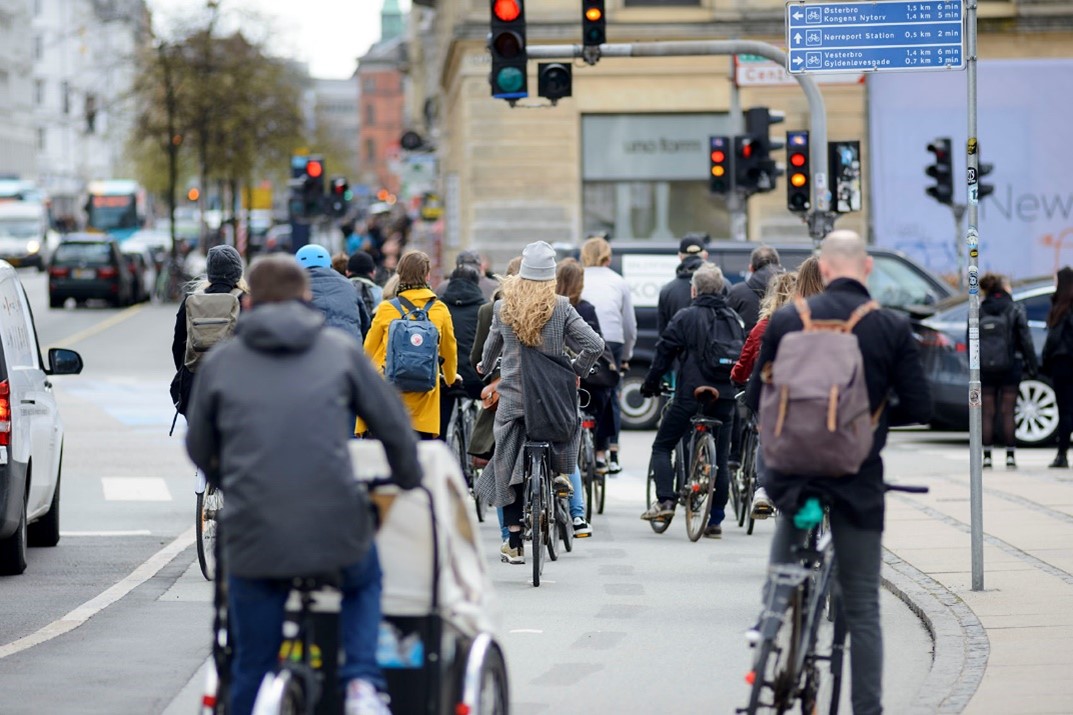
Establishing separate cyclist signals and advanced green signals gives cyclists a slight head start when the signal changes to green. This minimizes the risk of right-turn accidents. Allowing cyclists to turn right on red also ensures the possibility to turn right for cyclists even when the signal is red. Photo: The Cycle Superhighway Collaboration of the Capital Region of Denmark.
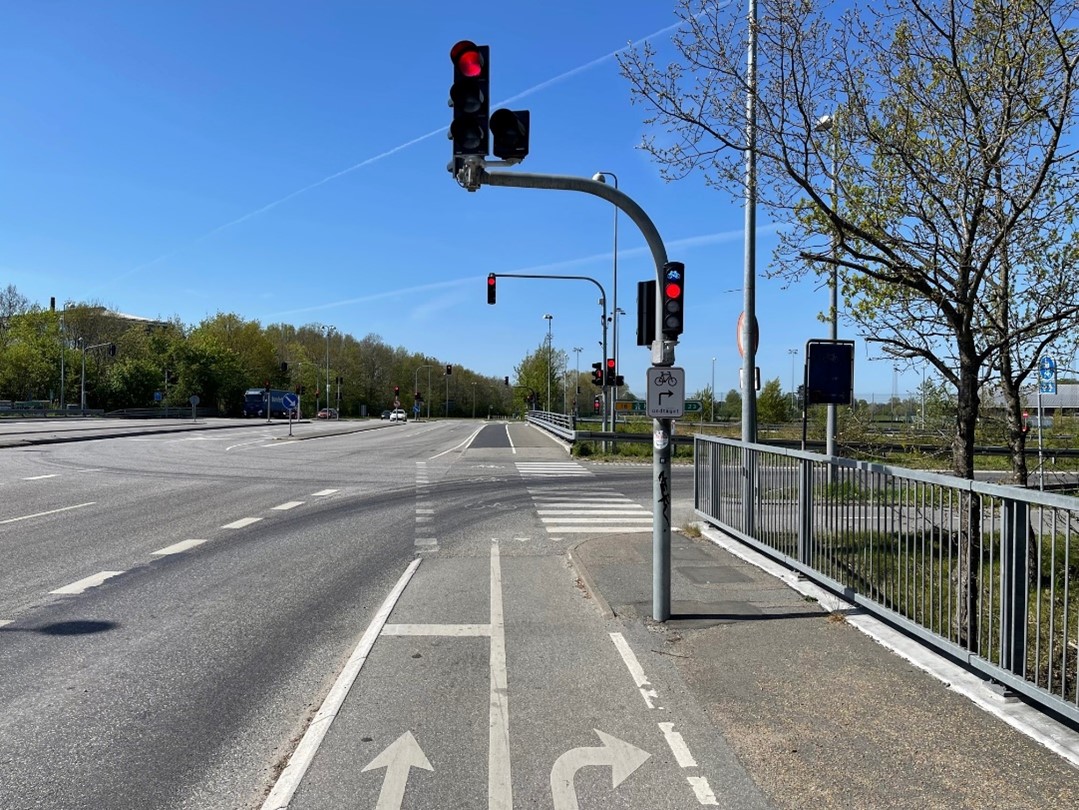
Separately regulated left turn for cyclists
If there are many left-turning cyclists at a signalized intersection, a separate left turn phase for cyclists can be established. This measure will improve traffic flow and real and perceived safety for left-turning cyclists. For traffic to and from other directions, it will reduce traffic flow, as the extra signal phase reduces the capacity of the signal system.
Things to Consider:
- The measure requires an additional phase in the signal system, in which many of the other traffic flows will need to have a red light, as they conflict with the left-turning cyclists.
Optimizing phase sequence for left-turning cyclists
In intersections with many signal phases, the traffic flow and real and perceived safety of left-turning cyclists can be optimized by inserting a phase in the signal control system. This ensures that the phase sequence does not result in left-turning cyclists having to wait a long time at the corner of the intersection before completing their turn. This is done by ensuring that left-turning cyclists at the corner get a green light immediately after the phase in which they have moved to the corner. In this way, the waiting time at the corner of the intersection is minimized, and it prevents the waiting cyclists from obstructing other traffic flows.
For example, the measure can improve intersections with separate right-turn arrows for drivers (and cyclists) at the corner where left-turning cyclists stop and wait.
By optimizing the left-turning cyclists’ execution of the turn, it prevents left-turning cyclists from blocking right-turning drivers and cyclists.
Separate regulation of right-turning cyclists
Separate regulation of right-turning cyclists can be a good idea if the cycle superhighway turns right at an intersection.
A signal phase must be inserted into the signal program, and a right-turn lane must be marked on the cycle track.
A right-turn lane on the cycle track will reduce the width for the cyclists going straight ahead and affect how quickly this direction can proceed through the intersection. Therefore, it is a good idea to assess whether the benefits for right-turning cyclists outweigh the disadvantages for cyclists going straight ahead before implementing the measure.
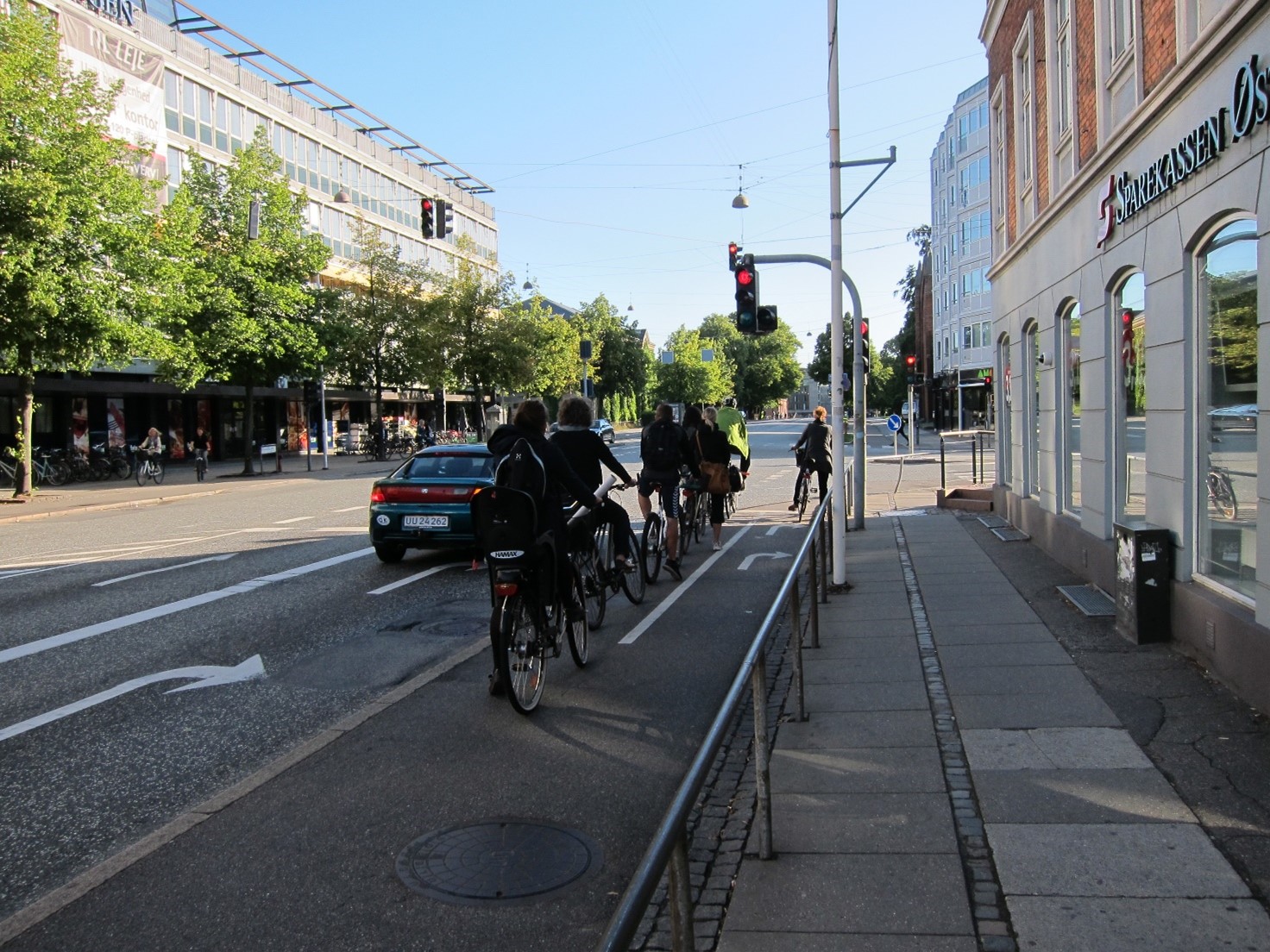
An uninterrupted cycle track established next to a right-turn lane for drivers is generally the preferred solution for a cycle superhighway. Channelizing the cycle track (i.e., providing a separate right-turn lane for cyclists) is a good idea if there is a separate right-turn phase at the signalized intersection. Photo: Pablo Celis.
Separate regulation of turning vehicles
In intersections with many or many potential accidents between turning drivers and cyclists, it can be an advantage for cyclists in terms of safety to separate turning vehicle traffic that is in conflict with cyclists. This can include conflicts with right- as well as left-turning motorists.
The solution is a safety measure where the phases for cyclists and motorists are separated, which often reduces the capacity of the intersection. There are geometry requirements for this solution, which often results in a larger intersection area.
More phases in a signal system usually lead to worse traffic flow, as flows that could otherwise be processed simultaneously are distributed across more phases. Additionally, phase changes require sufficient interstage time to clear conflict areas of traffic.
Large intersections with separate regulation of many traffic flows can feel unsafe for cyclists, as it can be challenging to navigate such intersections with numerous signals and phases to consider31Vejregler: Håndbog for Projektering af trafiksignaler, 2022. Section 6.6. Link.
Green Wave for Cyclists (Coordination)
A green wave for cyclists is a traffic flow measure designed to reduce the number of red light stops for cyclists along a route. This measure decreases delays for cyclists on stretches with coordinated signalized intersections. With a green wave for cyclists, the coordination is optimized according to the cyclists’ speed.
Compared to drivers, there is greater variation in cyclists’ speeds, so coordination for cyclists is particularly beneficial at closely spaced traffic signals. It is a good idea to consider what speed the green wave should be set at and adjust the coordination accordingly. Cyclists’ speeds typically vary depending on the time of day. In the City of Copenhagen, the green wave for cyclists is set based on an average speed of 20 km/h32Københavns Kommune: Grøn bølge 2.0 for cyklister på Østerbrogade, 2012. Link.
On hilly sections, it is especially important to aim for good coordination for cyclists going downhill, as it will be a significant advantage for both their traffic flow and safety if they do not have to brake at high speed when the signal changes as they approach the intersection.
It is a good idea to inform cyclists about the green wave along a route. This can be displayed on fixed signs, indicating the recommended speed for cyclists.
Information about a green wave in the City of Copenhagen. Photo: Monoline.
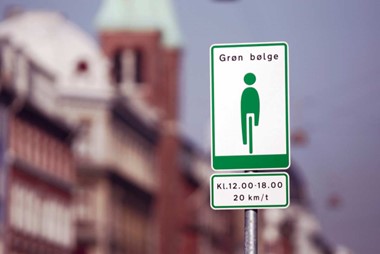
Supplementary Service Measures
On cycle superhighways, it is also recommended to implement extra service measures at signalized intersections. This could include foot rests and countdown signals that count down to the signal change, for example.
Click below to go directly to the Cycle Superhighway Collaboration’s recommendations for service measures:
Roundabouts
Roundabouts are often a good way to ensure both good traffic flow and safety for drivers. However, they can pose a challenge for cyclists – both in terms of traffic flow, safety and security.
When establishing a cycle superhighway, the route will sometimes have to pass through either an existing roundabout or a new roundabout. In both cases, there are significant differences in the recommendations for the design of cycling facilities along a cycle superhighway depending on whether the roundabout is located in an urban or rural setting.
Roundabouts are often used in Denmark to improve traffic safety, both in rural areas and in cities. Roundabouts can also be employed to reduce speed and are typically used when there is a significant amount of traffic from all directions at the intersection. In roundabouts, the risk of left-turn accidents and T-bone collisions is eliminated.
However, roundabouts do not always reduce the number of cycling collisions. On the contrary, all Danish and international studies show that converting to roundabouts increases the number of cycling collisions, and these collisions are no less severe. The majority of cycling collisions involve collisions with drivers entering as well as exiting the roundabout.
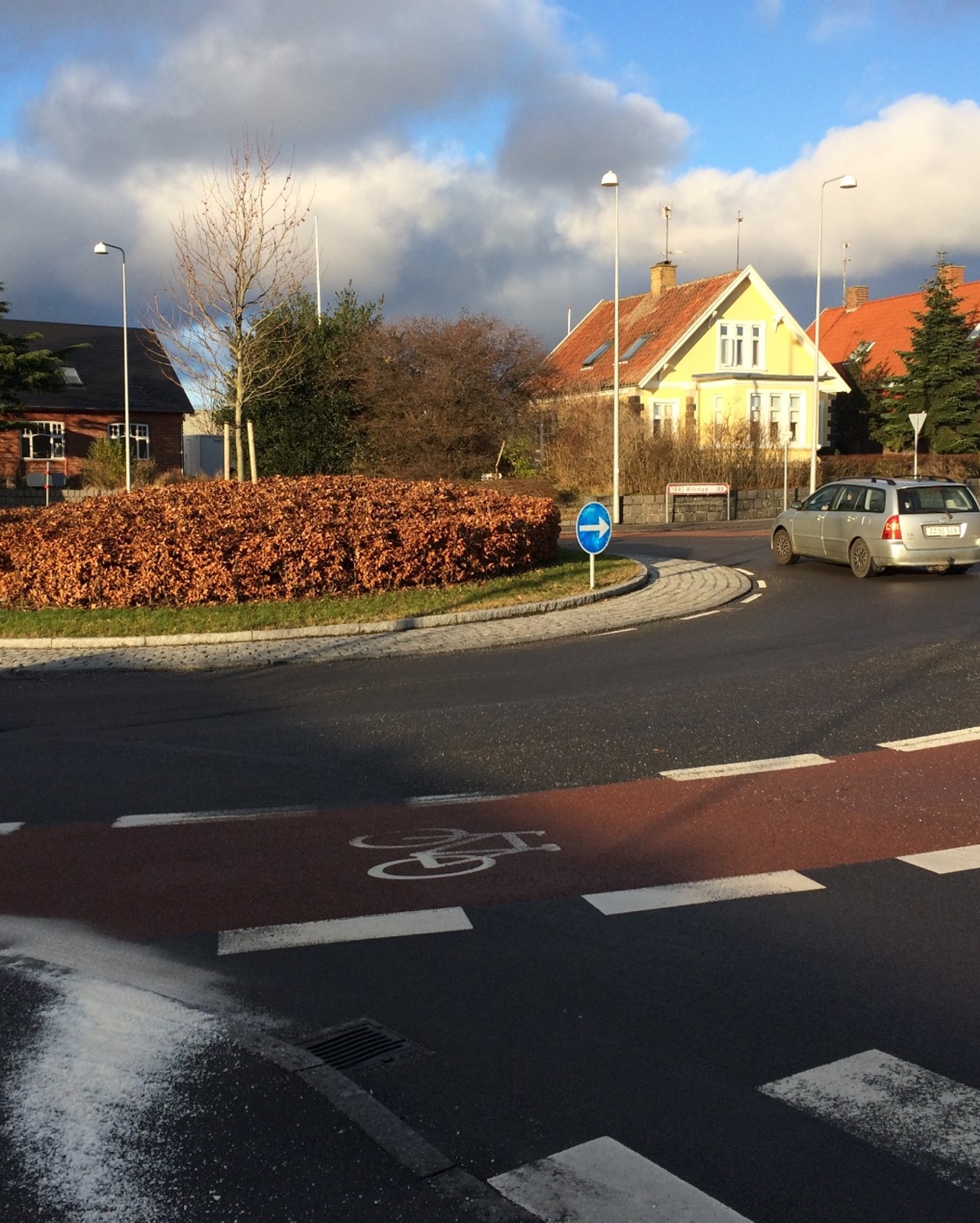
Cycle superhighways through roundabouts are generally not recommended unless special measures have been taken to reduce the speed of drivers. Photo: Pablo Celis
Below, you can read recommendations for designing cycling facilities in connection with both existing and new roundabouts on cycle superhighways in built-up areas and in open countryside:
Roundabouts in built-up areas
Establishing roundabouts are often a good way to ensure efficient traffic flow and safety for motorists. However, they can pose challenges for cyclists in terms of traffic flow, safety, and perceived safety.
Therefore, as a general recommendation, it is advised to find alternative routes for the cycle superhighway if it passes through an existing roundabout.
Recent research on cyclist safety in roundabouts indicates a clear but paradoxical relationship between cycling facilities within roundabouts and the number of accidents. The “better” the facilities established for cyclists within the roundabout, the more accidents tend to occur.
The latest traffic safety research shows33Transportøkonomisk institutt: Trafikksikkerhetshåndboken, 2023. Link, among other things:
More car traffic increases the risk of cycling collisions, while more cycling traffic reduces the risk. The lowest risk of collisions for individual cyclists is therefore found when there is low car traffic and high cycling traffic, whereas the highest risk exists when there is high car traffic and low cycling traffic.
The best safety for cyclists is found either with 100% integration with car traffic before and within the roundabout, meaning no dedicated cycling facilities, or with 100% separation, meaning a separate, set-back cycle path.
The worst safety is thus achieved when there is a cycle lane or cycle track in the roundabout and on the approaches, and especially if these are colored.
Speed reduction measures, such as raised surfaces on approaches to and exits from roundabouts, help reduce the number of collisions involving cyclists.
In general, roundabouts with few and perpendicular road segments have the lowest collision risk for cyclists. Few and perpendicular road segments should therefore be aimed for, but in practice, this can be challenging to achieve because roundabouts are sometimes established precisely where there are many and “irregular” road segments.
Roundabouts with no or few crosswalks have the lowest collision risk for cyclists. The number of crosswalks should therefore be limited for the safety of cyclists. However, crosswalks serve an important function for pedestrians crossing the roundabout.
Speed reduction measures
There is a clear correlation between the speed difference between drivers and cyclists at roundabouts and traffic safety: The higher the speed difference, the higher the collision risk for cyclists. Therefore, existing – as well as newly built – roundabouts that are to be part of a cycle superhighway should be made as speed-reducing for drivers as possible.
This can be achieved through the following measures:
- Expand the central island to narrow the circulating area (the roadway)
- Make entries and exits less dynamic
- Establish speed humps or speed tables for vehicles at entries and exits
Things to consider:
- Cycle lanes in roundabouts should be used with caution, as establishing a cycle lane essentially increases the circulating area that drivers can use to increase their speed. Additionally, the risk of cyclists being squeezed at the entries and exits is greater when there is no physical separation.
- Approach lanes should generally not be wider than 3.5 meters, but preferably narrower in small and medium-sized roundabouts. Exit lanes should not be wider than 4 meters. A truck apron with cobblestones surrounding the central island can make it easier for trucks and buses to pass through, but can also result in increased speed through the roundabout.
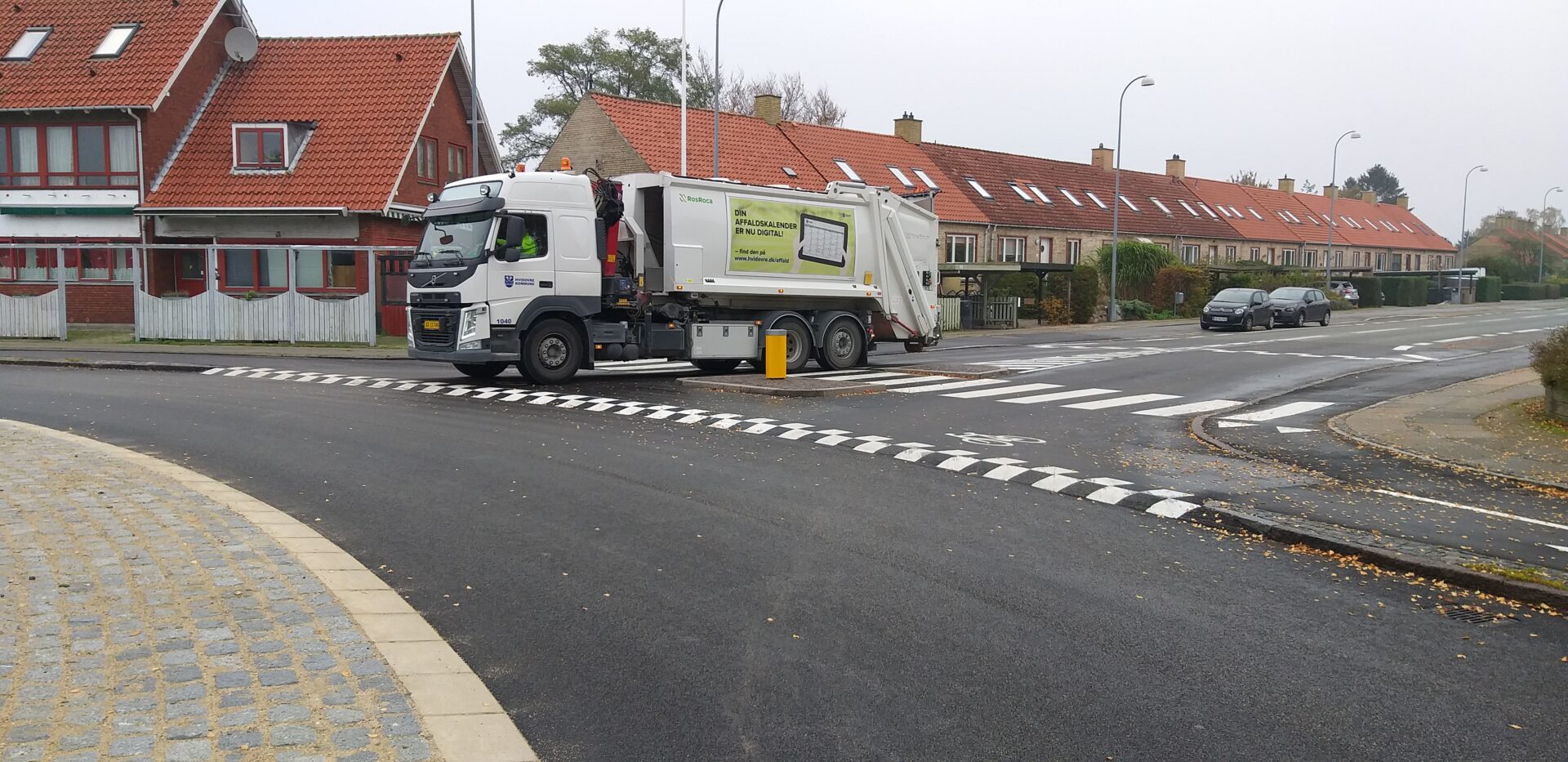
Roundabouts in rural areas
In rural areas, roundabouts are usually relatively dynamic, meaning that drivers can travel relatively fast through the roundabout. Therefore, solutions are typically used where cycle traffic is diverted away from the roundabout along bidirectional cycle paths, with cyclists being required to yield at the roundabout. This is the safest solution for cyclists but often results in long waiting times for cyclists and, in some cases, detours. Therefore, this solution is not recommended as part of a cycle superhighway.
If a cycle superhighway runs through a roundabout in rural areas, it is recommended to ensure traffic flow and safety for cyclists by grade separating the cycle track through the roundabout using either a tunnel or a bridge.
Side roads and crossings
Cyclists on cycle superhighways should be given priority when crossing side roads without traffic signals. This can be achieved through the following measures:
Recommendations for crossing side roads and driveways:
Crossing side roads without traffic signals
- Closing side roads and driveways.
- Establishing continuous cycle tracks across side roads – applicable to bidirectional cycle tracks as well. A continuous cycle track has a speed-reducing effect on drivers turning onto and out of side roads, as they have to cross over the cycle track, including its curb. The continuous cycle track helps side road traffic to more easily recognize and understand who has the right of way.
- If the curves of the side are too dynamic (allowing a soft turn), they should be made less dynamic. This means that turning drivers have to slow down to turn onto and out of the side road. This minimizes the risk of collisions.
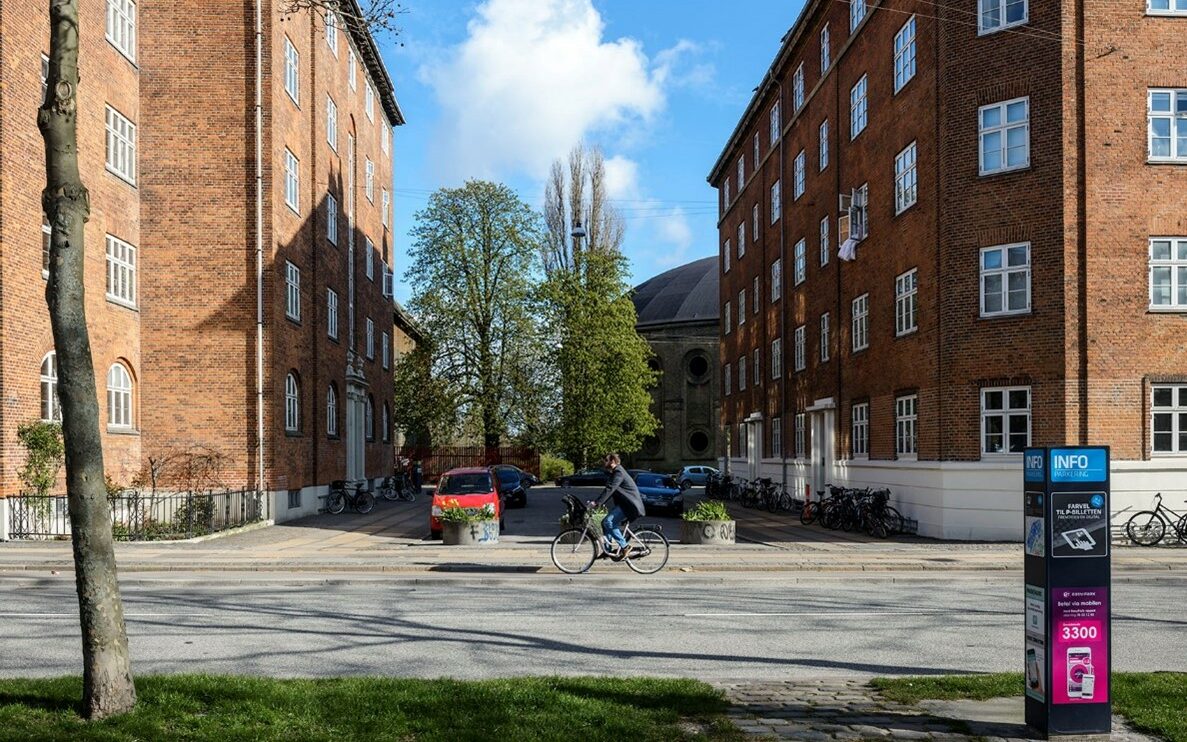
Principle for the design of a continuous cycle track. Continuing the cycle track across less busy side roads provides good traffic flow for cyclists. The AADT (Annual Average Daily Traffic) on the side road should not exceed 600-800 vehicles. Also remember to extend the sidewalk across the side road as shown in this example. Photo: The Cycle Superhighway Collaboration of the Capital Region of Denmark.
Crossings constructed with varying surfaces across a cycle track can create uncertainty about the right of way, while riding on cobblestones and similar surfaces can reduce comfort for cyclists. This solution is not recommended. Photo: Pablo Celis
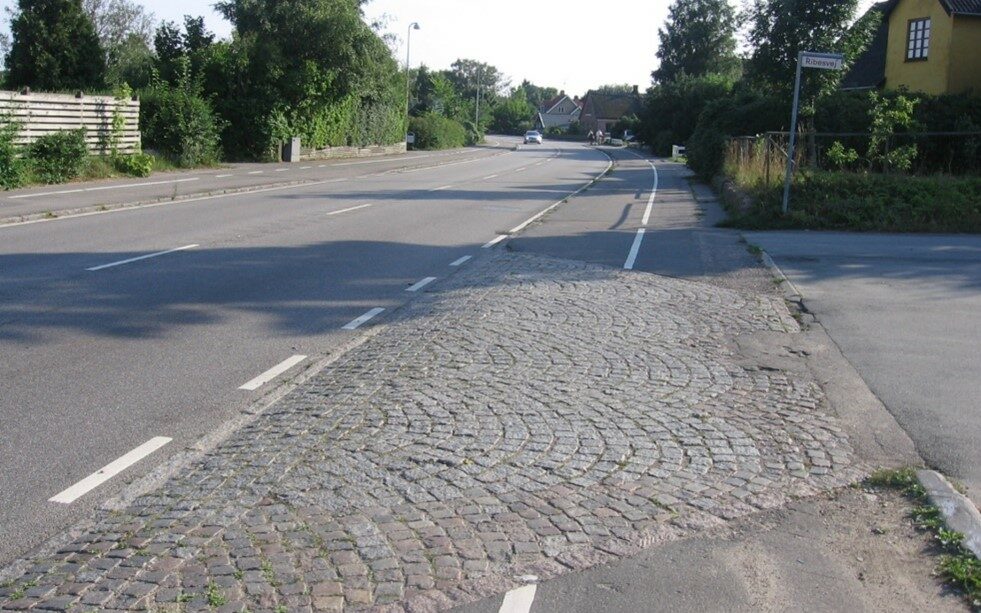
Concerning bi-directional cycle tracks across side roads
Bi-directional cycle tracks and intersections regulated by right of way are generally a poor combination. When choosing to build two-way cycle tracks along major roads, it is important to clearly highlight the conflict point at side roads for both cyclists and drivers.
__________________
If traffic volumes on the side road exceeds 600-800 vehicles per day, it should be considered to interrupt the bidirectional cycle track at the intersection and thus requiring cyclists to yield to road users on the side road. Preferably, move the cycle track 15-30 meters away from the main road to help cyclists better orient themselves at the crossing.
In such cases, a refuge island should always be provided so that cyclists can cross the road in two stages. The refuge island should be at least 2.5 meters long to safely accommodate irregular cycles (cycles with trailers, cargo bikes, etc.). Stop signs, B11 signs (unconditional duty to yield) or shark’s teeth can help to make the refuge island visible. Cycle barriers should not occur on a cycle superhighway.
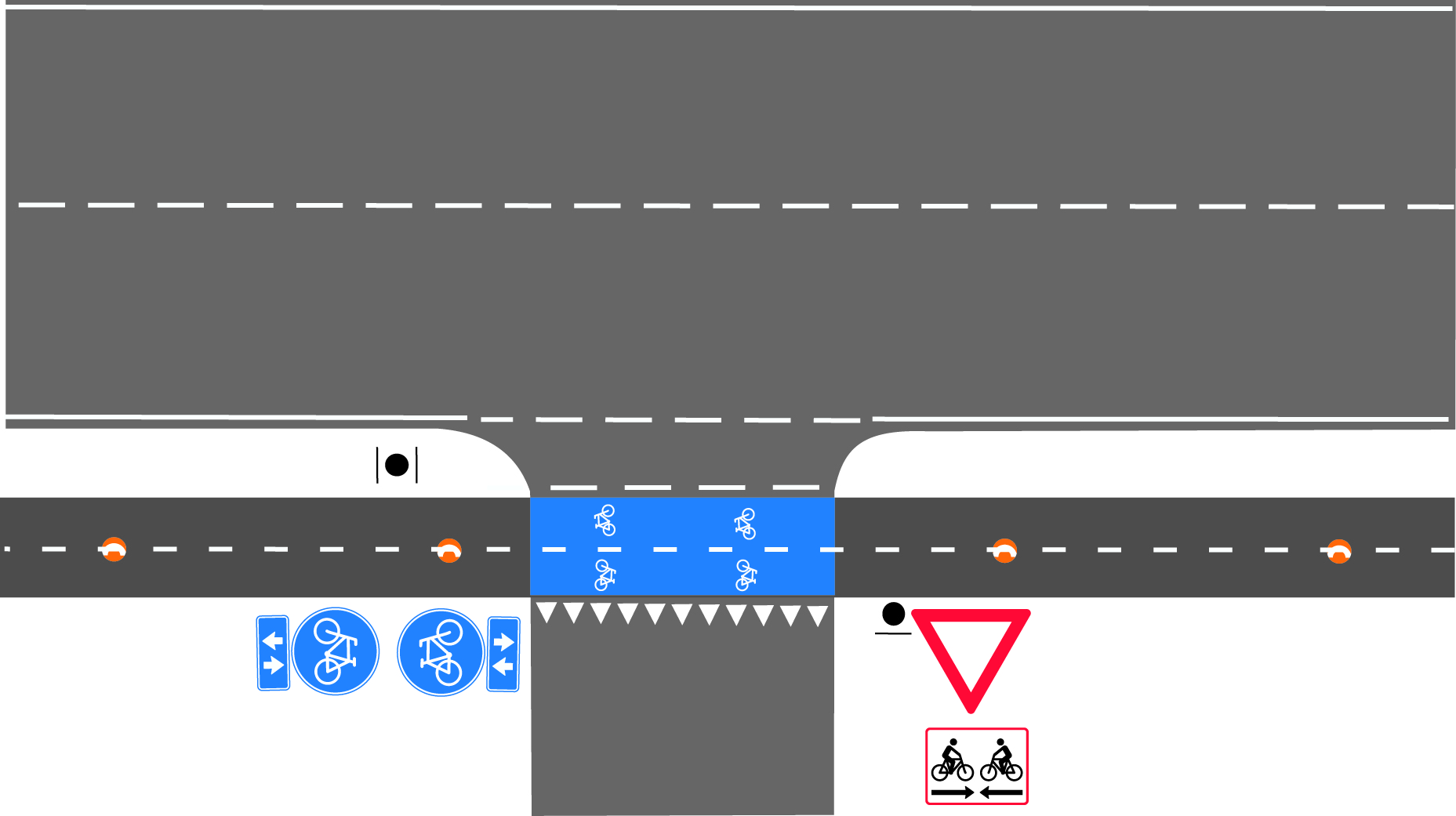
Principle for establishing a bi-directional cycle track across a minor road (AADT less than 600-800 vehicles).
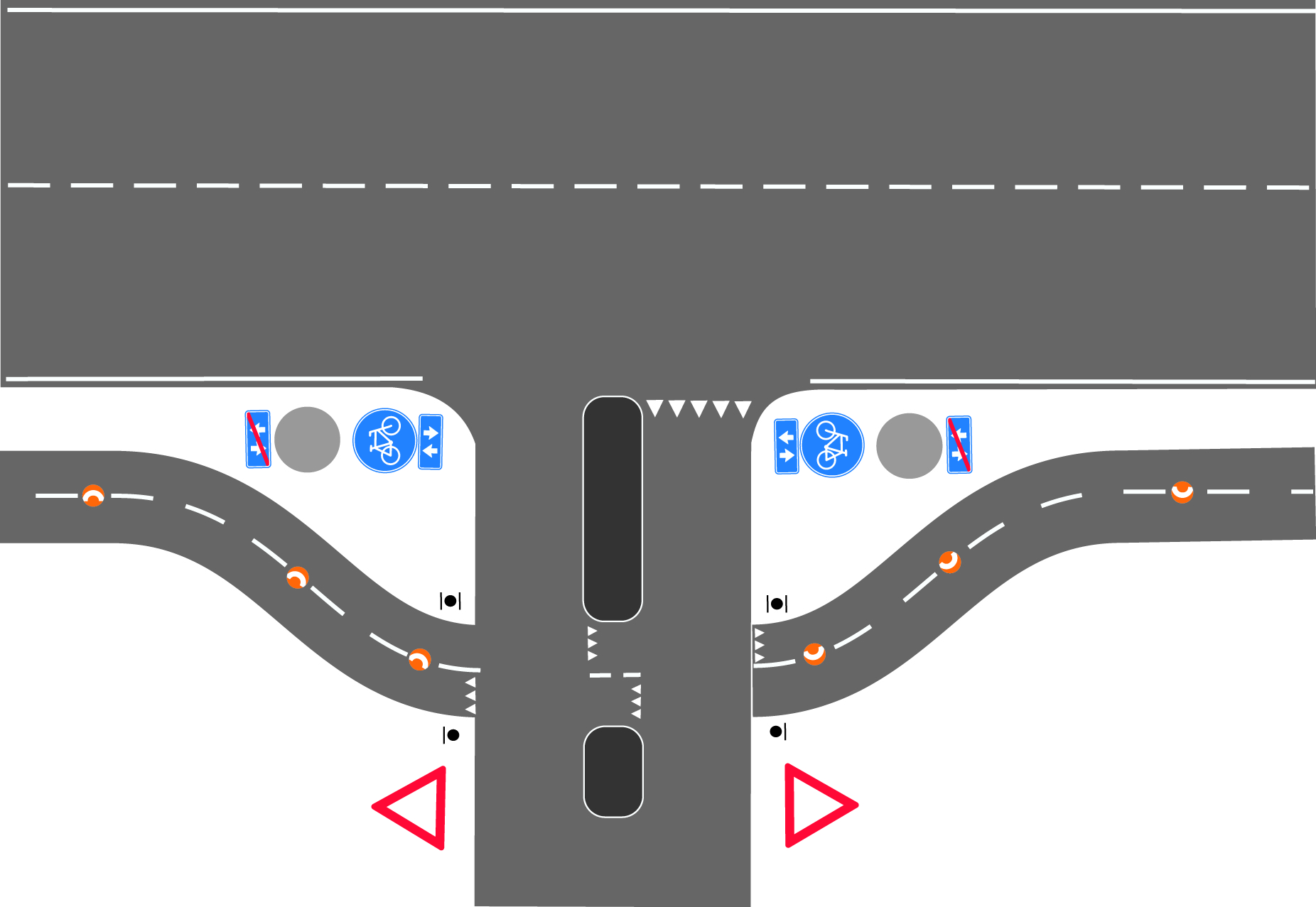
Principle for establishing a bi-directional cycle track across a busy side road (AADT over 600-800 vehicles) with cyclists required to yield. In such cases, a refuge island should always be established so that cyclists can cross the road in two stages. The refuge island should be at least 2.5 meters long to safely accommodate irregular cycles (cycles with trailers, cargo bikes, etc.).
When cyclists are required to yield, there should be at least 30-40 meters from the intersection of the road and the path to other intersections. This solution is not conducive to the traffic flow and perceived safety of cyclists but may be necessary for safety reasons and to accommodate drivers’ traffic flow. The 30-40 meter distance from other intersections is essential because cyclists at the intersection cannot account for traffic from all angles and directions simultaneously. However, there are intersections where a distance of 10-15 meters has proven to be sufficient.
____________________________
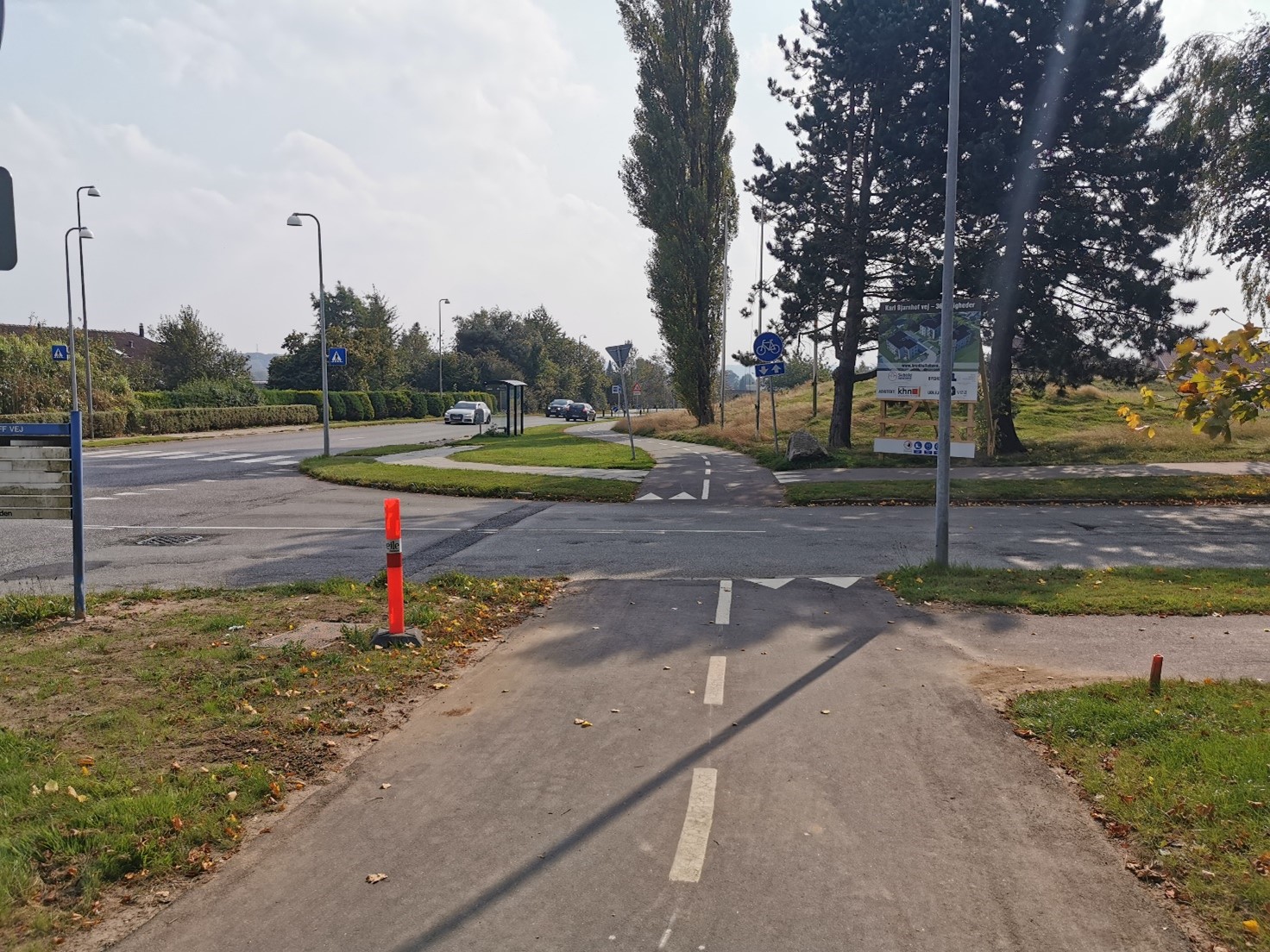
If the traffic volumes on the side road are too high (AADT more than 600-800 vehicles), cyclists should be required to yield at the crossing for safety reasons. In this example, the solution should be supplemented with B11 signs (unconditional duty to yield) on both sides of the intersection, and a refuge island should be established for the cyclists. Photo: Pablo Celis
_______________
Crossing other cycle paths and footpaths
When crossing other cycle paths and footpaths, it is recommended to prioritize the cycle superhighway. This can be done by clearly marking the duty to yield with shark’s teeth markings on the adjoining paths. Additionally, it is important to ensure good visibility at path junctions. Vegetation or sharp crossing angles can pose challenges for visibility.
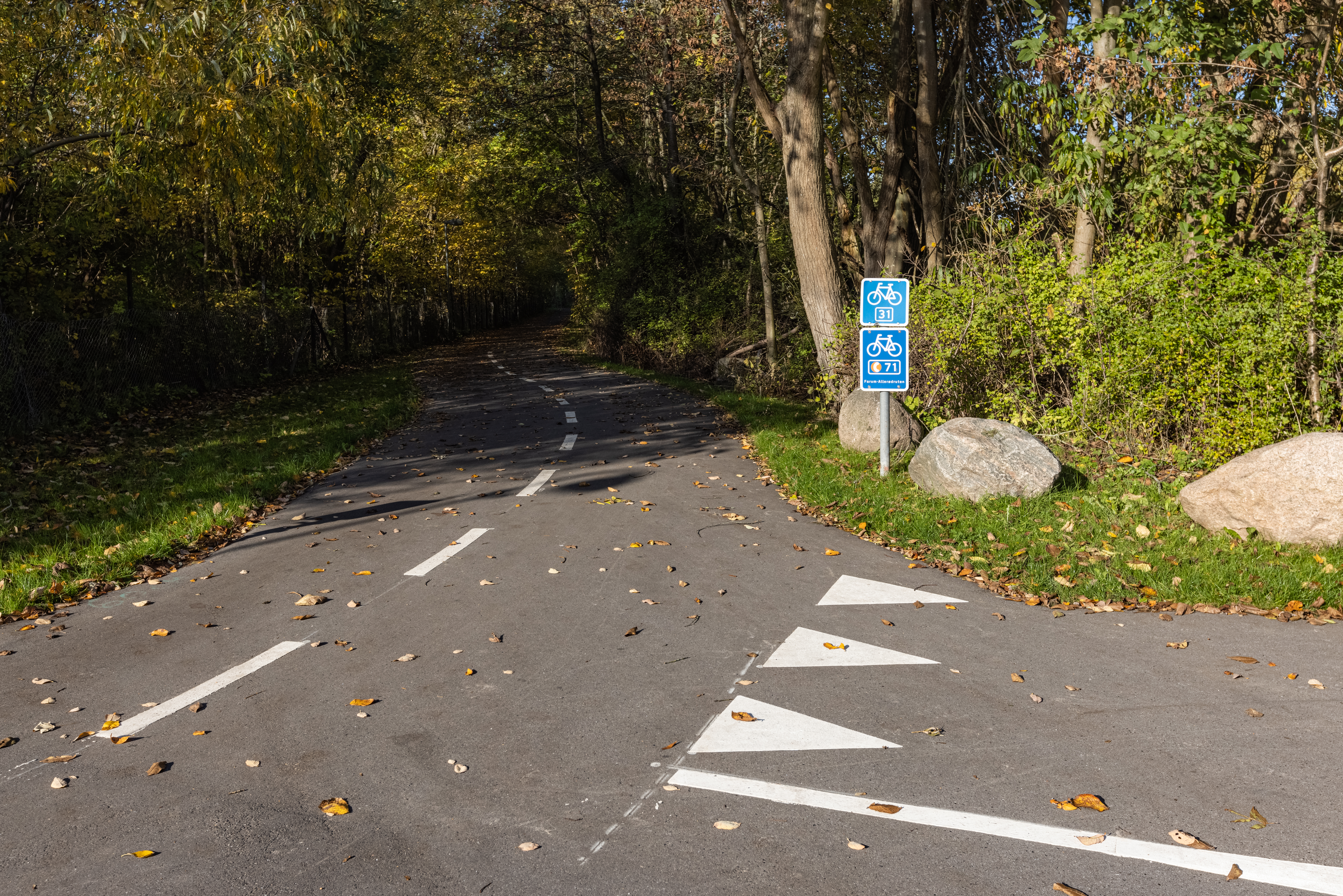
The crossings of the cycle superhighway with other paths must be marked with clear yield requirements, and good visibility must be ensured at the crossing. Photo: The Cycle Superhighway Collaboration of the Capital Region of Denmark.
Bus stops
If there are bus stops along a cycle superhighway, bus bulbs (bus boarders) should always be established for boarding and alighting passengers, potentially by routing the cycle track behind the bus stop in the form of a floating bus stop. This minimizes the risk of conflicts between bus passengers and cyclists. The bus bulb should be at least 2.0 meters wide to accommodate a disembarking passenger with a stroller or similar.
The cycle superhighways cover many types of routes with significant variation in the number of cyclists, buses, bus passengers, and in the design of cross-sections. Therefore, measures must be assessed on a case-by-case basis. On routes outside built-up areas, with low numbers of cyclists, buses, and bus passengers, it may be considered to forgo the establishment of bus bulbs at some stops and instead focus on establishing them at the busiest stops along the route. As a minimum, it is recommended to use the cycle superhighway logo or other road markings to increase the visibility of the cycle superhighway at stops with both low numbers of cyclists and low numbers of buses and passengers.
If the cycle superhighway is routed around the bus bulb (in the form of a floating bus stop), it is important to ensure that the curve for cyclists is not too sharp. This could mean that two cyclists cannot ride side by side through the curve, and it could also mean that larger cycles (such as cargo bikes and cycles with trailers) cannot safely pass through the curve without having to slow down too much.
A collection of key designs for bus stops are shown in the figure below::
The figure shows three effective designs for bus stops along cycle superhighways with a high volume of boarding and alighting passengers: Type A, Type B, and Type C.
Type A
Type A shows a bus stop with a bus bulb, where the course of the cycle superhighway is unchanged and straight. However, cyclists still have to deal with crossing pedestrians as the bus shelter is located on the right side of the cycle track.
Type B
Type B shows a bus stop with a bus bulb. The bus bulb is wide because the bus shelter is located on it. This means that waiting bus passengers do not rush onto the cycle track when the bus arrives, but may mean that the cycle superhighway has to make a bend to make room for the wide platform.
Type C
Type C shows a floating bus stop where the bus stops on the roadway. This solution can be considered when the cross-section is not wide enough to establish both a bus bay and a bus bulb, and/or when it is desired to prioritize bus flow over vehicle flow.
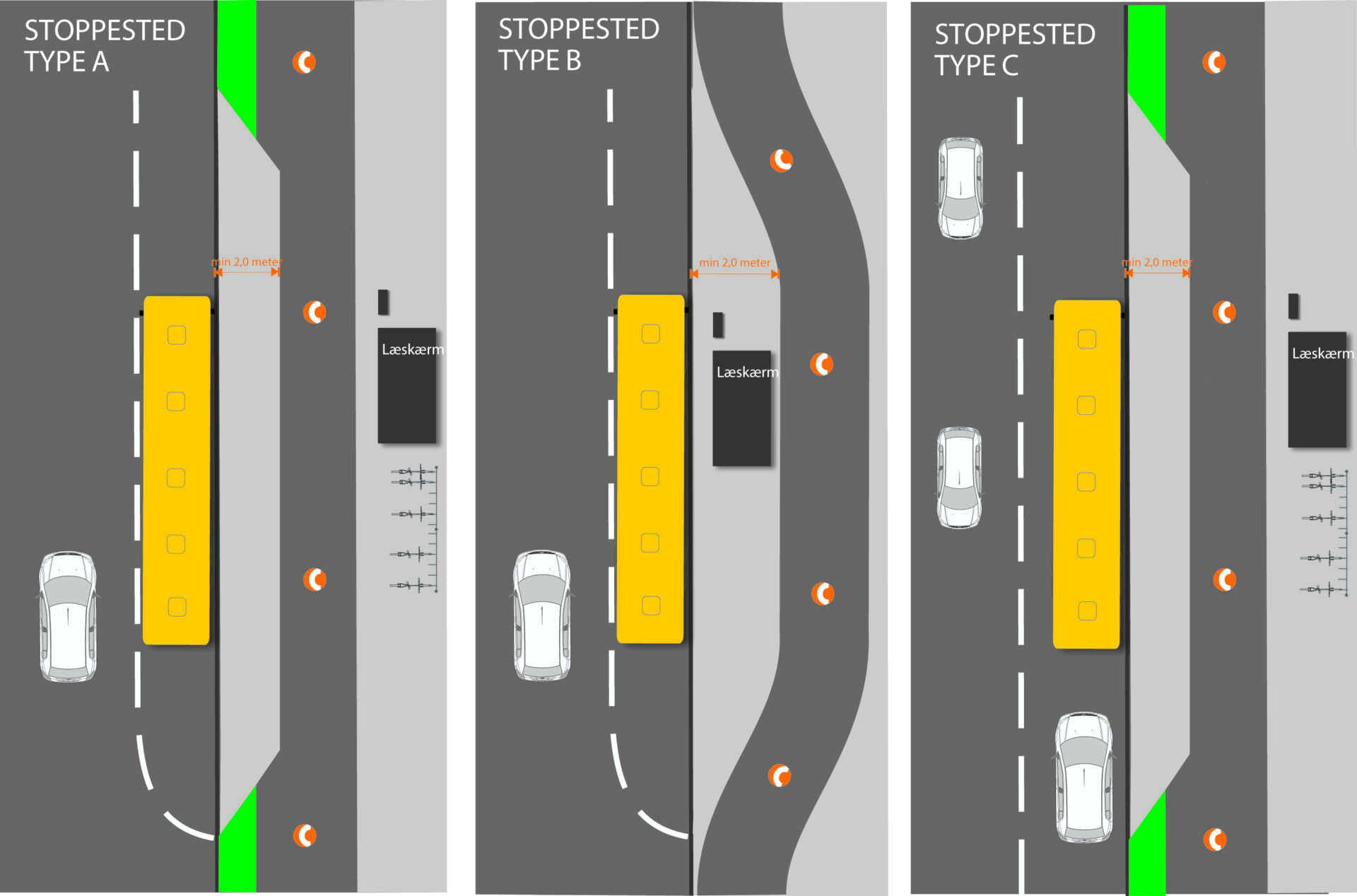
Bus stop Type B
The ideal bus stop where the cycle superhighway is routed behind the bus shelter. This solution minimizes conflicts between boarding and alighting bus passengers and cyclists. Photo: Pablo Celis
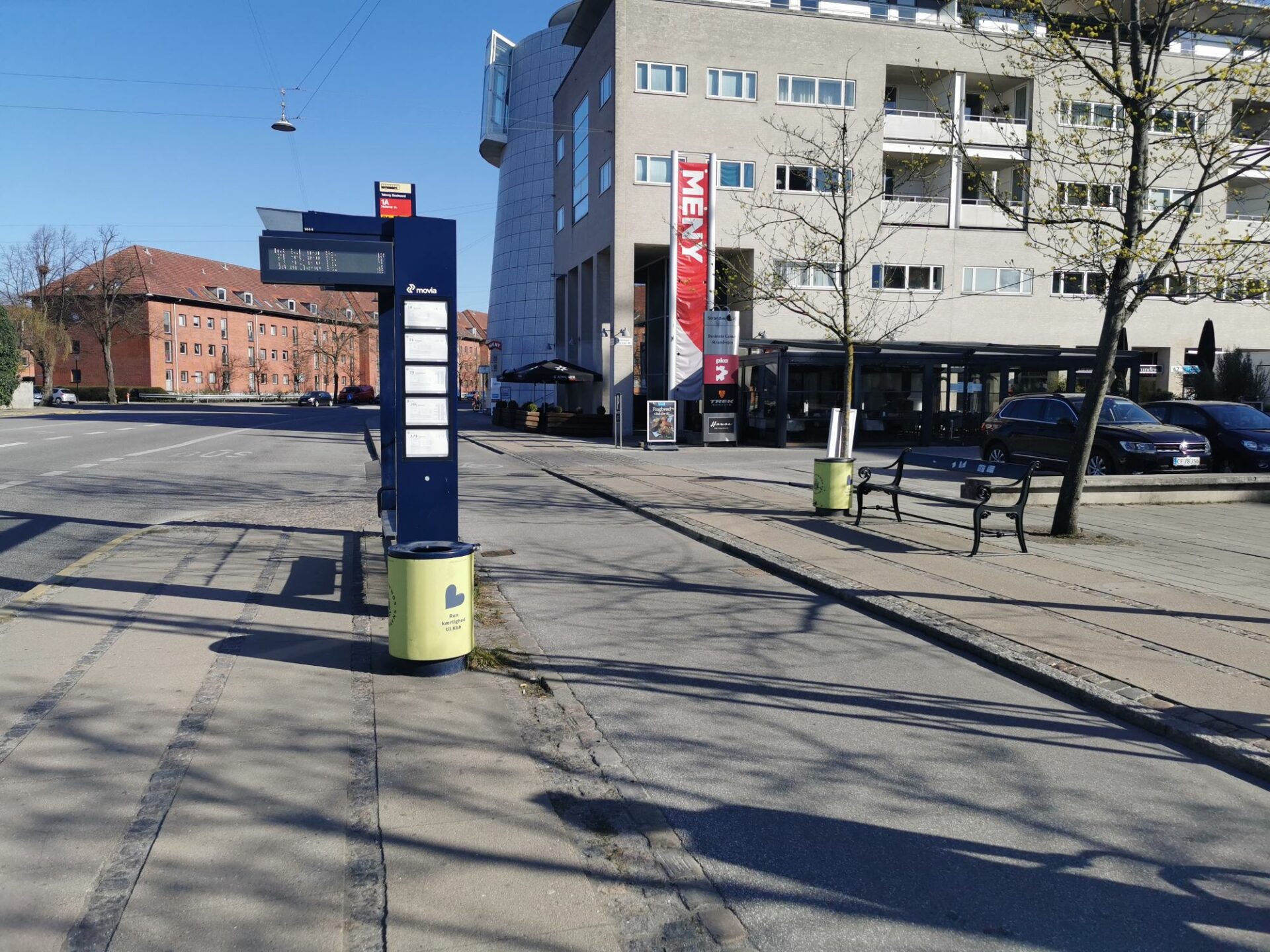

Bus stop Type C
Frederikssundruten. Photo: The Cycle Superhighway Collaboration of the Capital Region of Denmark.
References
- Transportministeriet: Cirkulære om vejregler for vejes geometri over og under broer, (CIR nr. 162 af 17/09/1998). Link
- Idékatalog for cykeltrafik: Signalregulerede kryds – gode cykelvenlige løsninger, 2019. Link
- Københavns Kommune: Grøn bølge 2.0 for cyklister på Østerbrogade, 2012. Link
- Transportøkonomisk institutt: Trafikksikkerhetshåndboken, 2015. Link
- Jensen, S. U.: Effekter af overkørsler og blå cykelfelter. Trafitec, 2006. Link
- Vejdirektoratet: Vejtekniske løsning for cyklister – Effekt på sikkerhed og oplevet tryghed, 2022. Link
- Vejregler: Håndbog for Brug af trafiksignaler, 2018. Link.
- Vejregler: Håndbog for Vejkryds i byer (2018) Link.
- Vejregler: Håndbog for Grundlag for udformning af trafikarealer. 2021 Link
- Vejregler: Projektering af trafiksignaler, 2022. Link
- Vejregler: Håndbog for Tracéring i byer 2016. Link





